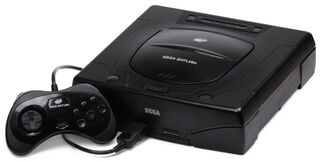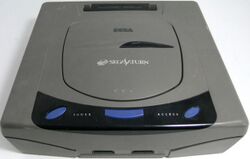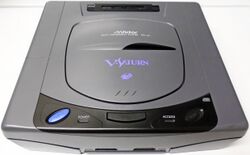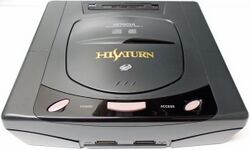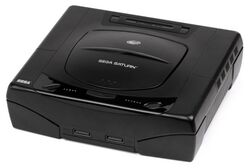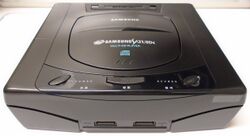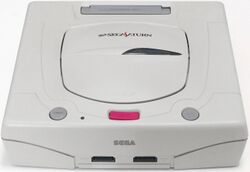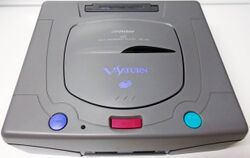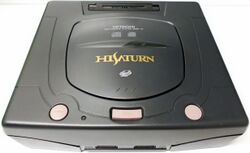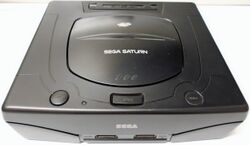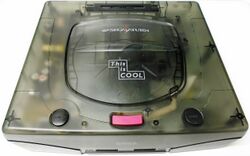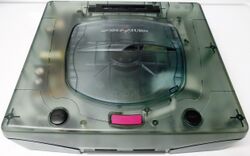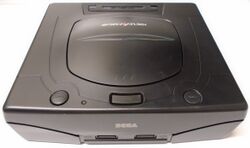|
|
| (125 intermediate revisions by 17 users not shown) |
| Line 1: |
Line 1: |
| | {{ConsoleBob | | {{ConsoleBob |
| − | | logos=[[File:Sega Saturn logo USA.png|320px]] | + | | | logo=Sega Saturn logo USA.png|320px]] |
| | | consoleimage=Saturn.jpg | | | consoleimage=Saturn.jpg |
| | | imgwidth=320px | | | imgwidth=320px |
| Line 9: |
Line 9: |
| | | add-ons=[[Saturn Backup Memory|Backup Memory]], [[Sega PriFun|PriFun]], [[Video CD Card]], [[Extended RAM Cartridge]], [[Saturn ROM Cartridge|ROM Cartridge]] | | | add-ons=[[Saturn Backup Memory|Backup Memory]], [[Sega PriFun|PriFun]], [[Video CD Card]], [[Extended RAM Cartridge]], [[Saturn ROM Cartridge|ROM Cartridge]] |
| | | releases={{releasesSat | | | releases={{releasesSat |
| − | | sat_date_jp=1994-11-22 | + | | sat_date_jp=1994-11-22{{fileref|Saturn JP TVAdvert SaturnFromSaturn.mp4}} |
| − | | sat_rrp_jp=80,800 | + | | sat_code_jp=HST-0001 |
| − | | sat_date_us=1995-05-11{{fileref|CVG UK 164.pdf|page=7}} | + | | sat_rrp_jp=44,800{{fileref|Saturn JP TVAdvert SaturnFromSaturn.mp4}} |
| − | | sat_rrp_us=399.99{{fileref|CVG UK 164.pdf|page=7}} | + | | sat_date_us=1995-05-11{{magref|cvg|164|7}} |
| − | | sat_date_eu=1995-07-08{{fileref|CVG UK 165.pdf|page=30}}
| + | | sat_code_us=MK-80001 |
| | + | | sat_rrp_us=399.99{{magref|cvg|164|7}} |
| | | sat_date_au=1995-07-08 | | | sat_date_au=1995-07-08 |
| − | | sat_rrp_uk=399.99 | + | | sat_code_uk=MK-80208-05 |
| − | | sat_date_br=1995-05-09 | + | | sat_date_uk=1995-07-08{{magref|cvg|165|30}}{{magref|ufg|9|12}} |
| − | | sat_rrp_br=800.00 | + | | sat_rrp_uk=399.99{{magref|ufg|9|12}} |
| − | | sat_date_as=1997 | + | | sat_date_br=1995-08-30{{magref|ag|91|10}} |
| − | | sat_date_kr=1995-10-20 | + | | sat_rrp_br=899.99{{magref|vg|54|36}} |
| − | | sat_code_kr=SPC-ST | + | | sat_date_as=1994-11<ref>New Straits Times 1997-03-13 Video game war front opens in Asia</ref> |
| | + | | sat_date_kr=1995-11-10 |
| | + | | sat_code_kr=SPC-SATURN |
| | | sat_rrp_kr=550,000 | | | sat_rrp_kr=550,000 |
| | | sat_date_fr=1995-07 | | | sat_date_fr=1995-07 |
| | | sat_rrp_fr=3,390{{fileref|ConsolesMicro FR 01.pdf|page=13}} | | | sat_rrp_fr=3,390{{fileref|ConsolesMicro FR 01.pdf|page=13}} |
| | | sat_date_de=1995-07-07 | | | sat_date_de=1995-07-07 |
| − | | sat_rrp_de=699{{fileref|SegaMagazin DE 21.pdf|page=6}} | + | | sat_rrp_de=699{{magref|segamagazin|21|6}} |
| − | | sat_date_es=1995-07-07{{fileref|HobbyConsolas ES 046.pdf|page=28}} | + | | sat_date_es=1995-07-07{{magref|hobbyconsolas|46|28}} |
| − | | sat_rrp_es=79,900{{fileref|HobbyConsolas ES 050.pdf|page=26}} | + | | sat_rrp_es=79,900{{magref|hobbyconsolas|50|26}} |
| | + | | sat_date_sa=1995{{magref|alaabalc|1|9}} |
| | + | | sat_rrp_sa=2300-2500{{magref|alaabalc|1|9}}{{magref|alaabalc|1|12}} |
| | + | | sat_date_pl=1996-03-01{{fileref|SecretService_34_PL_Bobmark.png}} |
| | + | | sat_rrp_pl=1200 |
| | + | | sat_date_ru=1995-03{{fileref|Migr 1 RU.pdf|page=57}} |
| | + | | sat_date_nl=1995-07-12 |
| | + | | sat_type_eu_1=Western Europe |
| | + | | sat_date_eu_1=1995-07-08 |
| | + | | sat_type_eu_2=Eastern Europe |
| | + | | sat_date_eu_2=1996-05<ref>https://www.telecompaper.com/news/32bit-consoles-to-be-launched-in-may-1996--81064</ref> |
| | }} | | }} |
| | }} | | }} |
| | + | <section begin=intro />The '''Sega Saturn''' (セガサターン), is a video game console manufactured by [[Sega]] as a successor to the [[Sega Mega Drive]]. It is a 32-bit compact disc-based system first released in November 1994 in Japan, before a Western launch across the following summer. |
| | | | |
| − | The '''Sega Saturn''' (セガサターン), is a video game console manufactured by [[Sega]] and was the successor to the [[Sega Mega Drive|Sega Mega Drive/Genesis]] (as opposed to add-ons such as the [[Sega 32X]] and [[Mega-CD]]). Initially released in 1994, the Saturn was a 32-bit compact disc-based system, and was a key player in what is now widely known as the fifth generation of video game consoles. The Saturn was first released on November 22, 1994 in Japan, May 11, 1995 in North America, and July 8, 1995 in Europe.
| + | Depending on where you live, the Saturn could be described as either Sega's most successful console of all time (Japan) or one of their biggest commercial failures (North America). Despite being powerful for its time, its complex hardware and inability to meet rapidly evolving consumer demands put it in a distant third place in the Western world, but a combination of 2D [[sprite]] games, 3D [[arcade]] ports and strong marketing campaigns made the Saturn the most successful Sega console in Japan. Estimates for the total number of Saturns sold worldwide range from 9.5 million to 17 million.{{intref|History of the Sega Saturn/Decline and legacy}}<section end=intro /> |
| | | | |
| − | Depending on where you live, the Saturn could be described as either Sega's most successful console of all time (Japan) or one of their biggest commercial failures (North America). Despite being powerful for its time, its complex hardware and inability to meet rapidly evolving consumer expectations and demands put it in a distant third place in the Western world, but a combination of 2D [[sprite]] games, 3D [[arcade]] ports and strong marketing campaigns made the Saturn the most successful Sega console in Japan. Estimates for the total number of Saturns sold worldwide range from 9.5 million to 17 million.{{intref|History of the Sega Saturn/Decline and legacy}}
| + | The Saturn's main competitors were [[Sony|Sony's]] [[PlayStation]] released just a week after the Saturn in Japan, and the [[Nintendo 64]] from June 1996. Its arcade counterpart was the [[Sega Titan Video]] (ST-V) system. It was succeeded by the [[Sega Dreamcast]] in late 1998. |
| | | | |
| − | The Saturn's main competitors were [[Sony]]'s PlayStation released just a week after the Saturn in Japan, and the Nintendo 64 from September 1996. Its arcade counterpart was the [[Sega Titan Video]] (ST-V) system. It was succeeded by the [[Sega Dreamcast]] in late 1998.
| + | "Saturn" was an internal codename that was carried through to the final product. It was named as such because Saturn is the sixth planet in our solar system, and this was Sega's sixth home console. Other Sega systems would also receive [[planet codenames]] over the next few years. |
| | | | |
| | <div class="toclimit-{{{1|{{{4|4}}}}}}">__TOC__</div> | | <div class="toclimit-{{{1|{{{4|4}}}}}}">__TOC__</div> |
| | | | |
| | ==Hardware== | | ==Hardware== |
| − | The Sega Saturn is the successor to the Mega Drive, though as a video game system it is almost entirely different. It is a "[[32-bit era|32-bit]]" console, marketed in such a way that it appeared to be an evolution of the "16-bit" era of video gaming dominated by the Mega Drive and Super NES (which in turn succeeded the "[[8-bit era|8-bit]]" [[Master System]] and NES, respectively). | + | The Sega Saturn is the successor to the Mega Drive, though as a video game system it is almost entirely different. It is a "32-bit" console, marketed in such a way that it appeared to be an evolution of the "16-bit" era of video gaming dominated by the Mega Drive and Super NES (which in turn succeeded the "8-bit" [[Master System]] and NES, respectively). |
| | | | |
| − | This description, however, was initially fabricated - Sega of Japan originally claimed the Saturn was a "64-bit" console{{fileref|SegaSaturn94JPCatalog.pdf}} and some within Sega even chose to call it an "128-bit" machine,{{fileref|Edge UK 024.pdf|page=9}} a number arrived at by cumulating processors rather than simply picking the main CPU. Alternatively some areas of Sega simply went down the "multi-processor" route, refusing to get drawn into the perceived differences between 32-bit and 64-bit.{{fileref|Hyper AU 003.pdf|page=8}} This was incidentally the last video game generation where these so-called "bit wars" were considered to matter. | + | This description, however, was initially fabricated - Sega of Japan originally claimed the Saturn was a "64-bit" console{{fileref|SegaSaturn64BitJPCatalog.pdf|page=3}} and some within Sega even chose to call it an "128-bit" machine,{{magref|edge|24|9}} a number arrived at by cumulating processors rather than simply picking the main CPU. Alternatively some areas of Sega simply went down the "multi-processor" route, refusing to get drawn into the perceived differences between 32-bit and 64-bit.{{magref|hyper|3|8}} This was incidentally the last video game generation where these so-called "bit wars" were considered to matter. |
| | | | |
| | The system uses CD-ROMs as its primary choice of media. Though it contains a cartridge slot, this is not used for games, but rather [[Saturn Backup Memory|backup memory]] or [[Saturn RAM Cartridge|RAM cartridges]]. The former was to extend the space for save games beyond that of the Saturn's internal memory, while the latter was used to augment the Saturn's limited memory and to avoid long CD load times. | | The system uses CD-ROMs as its primary choice of media. Though it contains a cartridge slot, this is not used for games, but rather [[Saturn Backup Memory|backup memory]] or [[Saturn RAM Cartridge|RAM cartridges]]. The former was to extend the space for save games beyond that of the Saturn's internal memory, while the latter was used to augment the Saturn's limited memory and to avoid long CD load times. |
| | | | |
| − | The Saturn has two controller ports, and the standard Saturn controller builds on that seen in the six button [[Control Pad (Mega Drive)|Sega Mega Drive controller]]. It adds two shoulder buttons, first seen on the Super NES controller, bringing the amount of buttons up to nine. The [[3D Control Pad]], released later with ''[[NiGHTS into Dreams]]'', would supply the console with an analogue stick and analogue shoulder buttons, the latter later being used in the Sega Dreamcast before being adopted by Nintendo and Microsoft for their GameCube and Xbox consoles, respectively. | + | The Saturn has two controller ports, and the standard Saturn controller builds on that seen in the six button [[Control Pad (Mega Drive)|Sega Mega Drive controller]]. It adds two shoulder buttons, first seen on the Super NES controller, bringing the amount of buttons up to nine. The [[3D Control Pad]], released later with ''[[NiGHTS into Dreams]]'', would supply the console with an analogue stick and analogue shoulder buttons, the latter later being used in the Sega Dreamcast before being adopted by [[Nintendo]] and [[Microsoft]] for their [[GameCube]] and [[Xbox]] consoles, respectively. |
| | | | |
| | The Sega Saturn hardware combined features from several [[List of Sega arcade systems|Sega arcade systems]].{{ref|[http://www.sega-saturn.com/saturn/other/tech.htm Technology That Defines the Next Generation: The Sega Saturn White Paper]}} It has a multi-processor system, like [[arcade]] machines. Its geometry engine consists of three [[wikipedia:Digital signal processor|DSP]] math processors, two inside both [[Hitachi]] [[SH-2]] CPU and one inside the SCU, which were all intended to be programmed in parallel using complex [[wikipedia:Assembly language|assembly language]], similar to how Sega programmed 3D arcade games at the time. | | The Sega Saturn hardware combined features from several [[List of Sega arcade systems|Sega arcade systems]].{{ref|[http://www.sega-saturn.com/saturn/other/tech.htm Technology That Defines the Next Generation: The Sega Saturn White Paper]}} It has a multi-processor system, like [[arcade]] machines. Its geometry engine consists of three [[wikipedia:Digital signal processor|DSP]] math processors, two inside both [[Hitachi]] [[SH-2]] CPU and one inside the SCU, which were all intended to be programmed in parallel using complex [[wikipedia:Assembly language|assembly language]], similar to how Sega programmed 3D arcade games at the time. |
| | | | |
| − | The [[VDP1]] was based on the [[:Category:Sega Model series|Sega Model series]], with a quad polygon engine based on the [[Model 1]], along with the [[Model 2]]'s [[wikipedia:Texture mapping|texture mapping]] capability. The VDP1 is capable of drawing more polygons than the Model 1, but less than the Model 2. The Saturn was also influenced by the Sega Model 1's use of a separate graphics processor for the 2D backgrounds (based on the [[Sega System 24]]). The quad polygons are drawn with [[wikipedia:Spatial anti-aliasing|edge anti‑aliasing]] (for smoother edges), [[wikipedia:Texture mapping#Forward texture mapping|forward texture mapping]] (a form of perspective correction), bilinear approximation (reduces texture warping), and medium polygon accuracy (resulting in seamless polygons).{{ref|[http://www.shinforce.com/saturn/information/3D-Capabilities.htm Sega Saturn 3D Capabilities]}} | + | The [[VDP1]] combined features from the [[Sega System 32]] and the [[:Category:Sega Model series|Sega Model series]], with a quad polygon engine based on the [[Model 1]], and [[wikipedia:Texture mapping|texture mapping]] capability based on the [[Model 2]] and [[System 32]]. The VDP1 is capable of drawing more polygons than the Model 1, but less than the Model 2. The Saturn was also influenced by the Sega Model 1's use of a separate graphics processor for the 2D backgrounds (based on the [[Sega System 24]]). The quad polygons are drawn with [[wikipedia:Spatial anti-aliasing|edge anti‑aliasing]] (for smoother edges), [[wikipedia:Texture mapping#Forward texture mapping|forward texture mapping]] (a form of perspective correction), bilinear approximation (reduces texture warping), and medium polygon accuracy (resulting in seamless polygons).{{ref|[http://www.shinforce.com/saturn/information/3D-Capabilities.htm Sega Saturn 3D Capabilities]}} |
| | | | |
| − | The Saturn's [[VDP2]] was based on [[Sega System 32]] technology (an evolution of [[Super Scaler]] technology), used for both 2D backgrounds and 3D planes; the latter can be manipulated as polygon objects. The VDP2's tiled infinite plane engine uses [[wikipedia:Tile engine|tilemap]] compression and a form of [[wikipedia:Scanline rendering|scanline]]/[[wikipedia:Tiled rendering|tiled rendering]] to draw large, detailed, 3D texture-mapped infinite planes (for things such as grounds, seas, walls, ceilings, skies, etc.), with [[wikipedia:Texture mapping#Perspective correctness|perspective correction]] and a virtually unlimited [[wikipedia:Draw distance|draw distance]] (and capable of effects such as transparency, parallax scrolling, reflective water surfaces, fog/misting,{{fileref|SSM UK 24.pdf|page=25}} fire, and heat haze), at a very high [[Fillrate|tile fillrate]] for its time. | + | The Saturn's [[VDP2]] was based on [[Sega System 32]] technology (an evolution of [[Super Scaler]] technology), used for both 2D backgrounds and 3D planes; the latter can be manipulated as polygon objects. The VDP2's tiled infinite plane engine uses [[wikipedia:Tile engine|tilemap]] compression and a form of [[wikipedia:Scanline rendering|scanline]]/[[wikipedia:Tiled rendering|tiled rendering]] to draw large, detailed, 3D texture-mapped infinite planes (for things such as grounds, seas, walls, ceilings, skies, etc.), with [[wikipedia:Texture mapping#Perspective correctness|perspective correction]] and a virtually unlimited [[wikipedia:Draw distance|draw distance]] (and capable of effects such as transparency, parallax scrolling, reflective water surfaces, fog/misting,{{magref|ssm|24|25}} fire, and heat haze), at a very high [[Fillrate|tile fillrate]] for its time. |
| | | | |
| | The VDP2 draws 3D infinite planes as large as 4096×4096 pixels at 30 FPS, equivalent to a [[fillrate]] of over 500 [[Pixel|MPixels/s]], significantly larger than what any console or PC hardware were capable of with polygons at the time. It requires 1 million texture-mapped polygons/sec, with 500 pixels per polygon, to draw a texture-mapped 4096×4096 infinite plane at 30 FPS; the [[Dreamcast]] was the first home system capable of doing this with polygons, as it was the first home system that exceeded 500 MPixels/s polygon fillrate (using tiled rendering). | | The VDP2 draws 3D infinite planes as large as 4096×4096 pixels at 30 FPS, equivalent to a [[fillrate]] of over 500 [[Pixel|MPixels/s]], significantly larger than what any console or PC hardware were capable of with polygons at the time. It requires 1 million texture-mapped polygons/sec, with 500 pixels per polygon, to draw a texture-mapped 4096×4096 infinite plane at 30 FPS; the [[Dreamcast]] was the first home system capable of doing this with polygons, as it was the first home system that exceeded 500 MPixels/s polygon fillrate (using tiled rendering). |
| Line 58: |
Line 72: |
| | The Saturn was known for its difficult 3D development environment (especially for third-party developers), including its complex parallel processing hardware architecture, requiring familiarity with assembly language, lack of an operating system, and initial lack of C language support, useful development tools and graphics software libraries. Sega eventually provided [[Sega DTS Saturn official documentation|DTS]] support for these features in late 1995. However, the C language development tools were not very well optimized for Saturn hardware, only tapping into a fraction of the Saturn's power, compared to assembly language which could tap into most of the Saturn's power. For example, the libraries did not use the SCU DSP, nor were they well-optimized for a multi-core CPU setup.{{ref|[https://farm6.staticflickr.com/5628/23262355633_f3b5b12bb0_b.jpg Pure Entertainment Interview]}} Some of the advanced techniques used by Sega's first-party [[:Category:Sega Development Companies|AM studios]] did not become available until the introduction of [[Sega DTS Saturn official documentation|SGL]] (Saturn Graphics Library).{{ref|[https://farm1.staticflickr.com/595/23262347513_29a2ff6e2a_b.jpg Jason Gosling (Core Design) Interview] (''[[wikipedia:Edge (magazine)|Edge]]'')}} | | The Saturn was known for its difficult 3D development environment (especially for third-party developers), including its complex parallel processing hardware architecture, requiring familiarity with assembly language, lack of an operating system, and initial lack of C language support, useful development tools and graphics software libraries. Sega eventually provided [[Sega DTS Saturn official documentation|DTS]] support for these features in late 1995. However, the C language development tools were not very well optimized for Saturn hardware, only tapping into a fraction of the Saturn's power, compared to assembly language which could tap into most of the Saturn's power. For example, the libraries did not use the SCU DSP, nor were they well-optimized for a multi-core CPU setup.{{ref|[https://farm6.staticflickr.com/5628/23262355633_f3b5b12bb0_b.jpg Pure Entertainment Interview]}} Some of the advanced techniques used by Sega's first-party [[:Category:Sega Development Companies|AM studios]] did not become available until the introduction of [[Sega DTS Saturn official documentation|SGL]] (Saturn Graphics Library).{{ref|[https://farm1.staticflickr.com/595/23262347513_29a2ff6e2a_b.jpg Jason Gosling (Core Design) Interview] (''[[wikipedia:Edge (magazine)|Edge]]'')}} |
| | | | |
| − | Only a handful of developers were able to squeeze most of the power out of the second SH-2 CPU, and even fewer utilized the SCU DSP, as its assembly code was more complex than the SH-2. Assembly language was often used by Japanese and British developers, but rarely used by American developers who preferred C language.{{fileref|Edge UK 030.pdf|page=99}} The VDP1 rendered quadrilateral polygons, which, despite being used by the most powerful gaming system at the time ([[Sega Model 2]] arcade system), did not become industry standard for 3D graphics, compared to the more widely used triangle polygons. | + | Only a handful of developers were able to squeeze most of the power out of the second SH-2 CPU, and even fewer utilized the SCU DSP, as its assembly code was more complex than the SH-2. Assembly language was often used by Japanese and British developers, but rarely used by American developers who preferred C language.{{magref|edge|30|99}} The VDP1 rendered quadrilateral polygons, which, despite being used by the most powerful gaming system at the time ([[Sega Model 2]] arcade system), did not become industry standard for 3D graphics, compared to the more widely used triangle polygons. |
| | | | |
| | The VDP2's tiled infinite plane engine, which could draw large 3D infinite planes with a much higher draw distance, texture details and fillrate than polygons at the time, was unfamiliar to most developers who relied on polygons to construct 3D planes. Sega's first-party 3D games often utilized both CPU, the DSP, and/or both VDP, but the hardware's complexity and difficult 3D development environment led to most third-party developers only utilizing a single CPU and the VDP1, just a portion of the Saturn's power, for 3D games. This was also partly due to the advanced techniques used by Sega's first-party studios being unavailable to third-party developers until the introduction of SGL.{{ref|[https://farm1.staticflickr.com/595/23262347513_29a2ff6e2a_b.jpg Jason Gosling (Core Design) Interview] (''[[wikipedia:Edge (magazine)|Edge]]'')}} While the VDP2 was under-utilized for 3D games, it was frequently used for 2D games, where the VDP1 draws [[sprite]]s and the VDP2 draws scrolling backgrounds. | | The VDP2's tiled infinite plane engine, which could draw large 3D infinite planes with a much higher draw distance, texture details and fillrate than polygons at the time, was unfamiliar to most developers who relied on polygons to construct 3D planes. Sega's first-party 3D games often utilized both CPU, the DSP, and/or both VDP, but the hardware's complexity and difficult 3D development environment led to most third-party developers only utilizing a single CPU and the VDP1, just a portion of the Saturn's power, for 3D games. This was also partly due to the advanced techniques used by Sega's first-party studios being unavailable to third-party developers until the introduction of SGL.{{ref|[https://farm1.staticflickr.com/595/23262347513_29a2ff6e2a_b.jpg Jason Gosling (Core Design) Interview] (''[[wikipedia:Edge (magazine)|Edge]]'')}} While the VDP2 was under-utilized for 3D games, it was frequently used for 2D games, where the VDP1 draws [[sprite]]s and the VDP2 draws scrolling backgrounds. |
| Line 82: |
Line 96: |
| | | | |
| | ====HST-3220==== | | ====HST-3220==== |
| − | Released in March 1996, the HST-3220 stands as the only significant change to the Saturn's design, although functionality wise, the only feature omitted is the "access" LED seen in previous models. Reportedly the change in colour scheme was made to appeal to younger and female demographics.{{fileref|MAXIMUM UK 06.pdf|page=127}}
| + | Announced at [[Sega Saturn Power Up Meeting '96 Spring]] and released on 22nd March 1996{{magref|saturnfan|1996-07|25}}, the HST-3220 stands as the only significant change to the Saturn's design, although functionality wise, the only feature omitted is the "access" LED seen in previous models. Reportedly the change in colour scheme was made to appeal to younger and female demographics.{{magref|maximum|6|127}} |
| | | | |
| | These "white" Saturns likely cost less to produce (they were certainly sold for a lot less in Japan), but from a user perspective the change is largely negligible - the console is roughly the same size and has no problems running any Saturn software. White Saturns opt for grey "circle" power and reset buttons and a pink "open" button for lifting the lid. | | These "white" Saturns likely cost less to produce (they were certainly sold for a lot less in Japan), but from a user perspective the change is largely negligible - the console is roughly the same size and has no problems running any Saturn software. White Saturns opt for grey "circle" power and reset buttons and a pink "open" button for lifting the lid. |
| Line 98: |
Line 112: |
| | Sega Saturn PAL model 2.jpg|European model | | Sega Saturn PAL model 2.jpg|European model |
| | Sega Saturn HST-0020.jpg|Japanese "This is Cool" model | | Sega Saturn HST-0020.jpg|Japanese "This is Cool" model |
| | + | Saturn_JP_HST-0022.jpg|Japanese "Derby Stallion" model |
| | + | Saturn_KR_Kama.jpg|Korean model |
| | </gallery> | | </gallery> |
| | + | |
| | + | ===Hardware revisions=== |
| | + | {{mainArticle|{{PAGENAME}}/Hardware revisions}} |
| | | | |
| | ===Technical specifications=== | | ===Technical specifications=== |
| − | ====Processors====
| + | {{mainArticle|Sega Saturn/Technical specifications}} |
| − | {{multicol| | |
| − | * Main CPU: 2× [[SH-2|Hitachi SH-2]] @ 28.63636 MHz{{intref|Sega Saturn hardware notes (2004-04-27)}}{{fileref|Hitachi SuperH Programming Manual.pdf}}{{fileref|SH7604 Hardware Manual.pdf}}
| |
| − | ** Configuration: [[wikipedia:Master/slave (technology)|Master/Slave]]
| |
| − | ** 2x CPU cores: 32‑bit [[wikipedia:Reduced instruction set computing|RISC]] instructions/[[wikipedia:Processor register|registers]], 74.454536 [[wikipedia:Instructions per second|MIPS]] (37.227268 MIPS each, 1.3 MIPS per MHz),{{fileref|SH-2A.pdf|page=2}}{{ref|[https://www.renesas.com/en-eu/products/microcontrollers-microprocessors/superh/sh7040/sh7040.html SH7040, SH7041, SH7042, SH7043, SH7044, SH7045], Renesas}} up to 4 instructions/cycle (2 instructions/cycle per SH-2){{fileref|Hitachi SuperH Programming Manual.pdf|page=390}}
| |
| − | ** 2x DMA units: 2x DMAC (Direct Memory Access Controller),{{fileref|SH7604 Hardware Manual.pdf|page=3}} parallel processing{{fileref|SH7604 Hardware Manual.pdf|page=219}}
| |
| − | ** 4x internal [[wikipedia:Fixed-point arithmetic|fixed‑point]] math processors:{{fileref|Sega Service Manual - Sega Saturn (PAL) - 013-1 - June 1995.pdf}} 2x MULT multiplier DSP,{{fileref|SH7604 Hardware Manual.pdf|page=3}}{{fileref|SH7604 Hardware Manual.pdf|page=22}}{{fileref|ST-103-R1-040194.pdf|page=23}} 2x DIVU division units,{{fileref|SH7604 Hardware Manual.pdf|page=3}}{{fileref|SH7604 Hardware Manual.pdf|page=22}} parallel processing{{fileref|SH7604 Hardware Manual.pdf|page=303}}
| |
| − | *** 2x MULT multiplier DSP: 57.27272 MOPS{{ref|MOPS (million operations per second)|group=fn}} fixed-point math (28.63636 MOPS per SH-2){{ref|1 operation per cycle{{fileref|Hitachi SuperH Programming Manual.pdf|page=31}}|group=fn}}
| |
| − | *** 2x DIVU division units: 16/32/64-bit division,{{fileref|SH7604 Hardware Manual.pdf|page=303}} 1,468,531 divides/sec{{ref|39 cycles per divide{{fileref|Hitachi SuperH Programming Manual.pdf|page=155}}|group=fn}}
| |
| − | ** [[wikipedia:Bus (computing)|Bus]] width: 64‑bit (2× 32‑bit) internal, 32‑bit external{{fileref|ST-103-R1-040194.pdf}}
| |
| − | ** Word length: [[32-bit era|32-bit]]
| |
| − | * System coprocesor: Custom Saturn Control Unit (SCU), with DSP for geometry processing and DMA controller for system control{{fileref|ST-103-R1-040194.pdf}}{{fileref|Sega Service Manual - Sega Saturn (PAL) - 013-1 - June 1995.pdf}}{{fileref|ST-097-R5-072694.pdf}}
| |
| − | ** System control processor: 32‑bit fixed‑point registers/instructions, [[wikipedia:Raster interrupt|interrupt]] controller, DMA controller, 3 [[wikipedia:Direct memory access|DMA]] channels
| |
| − | ** Math coprocessor: Geometry [[wikipedia:Digital signal processor|DSP]] @ 14.31818 MHz, 32‑bit fixed‑point instructions, 6 parallel instructions per cycle,{{fileref|ST-TECH.pdf|page=157}} 85.90908 MIPS (6 MIPS per MHz)
| |
| − | * CD‑ROM CPU: [[SuperH|Hitachi SH-1]] 32‑bit [[RISC]] processor @ 20 MHz (20 MIPS){{fileref|Hitachi SuperH Programming Manual.pdf}} (controlling the CD‑ROM)
| |
| − | ** Contains internal DAC and internal math processor{{fileref|Sega Service Manual - Sega Saturn (PAL) - 013-1 - June 1995.pdf}}
| |
| − | ** Bus width: 32‑bit internal, 16‑bit external{{fileref|ST-103-R1-040194.pdf}}
| |
| − | * Microcontroller: [[Hitachi]] HD404920{{ref|[https://github.com/mamedev/mame/blob/master/src/mame/drivers/saturn.cpp Sega Saturn (MAME)]}} (4‑bit MCU) "System Manager & Peripheral Control" (SMPC) @ 4 MHz{{fileref|Sega Service Manual - Sega Saturn (PAL) - 013-1 - June 1995.pdf}}
| |
| − | ** RTC: 1 MHz{{fileref|ST-103-R1-040194.pdf}} (real‑time clock)
| |
| − | ** Instruction set: 4‑bit instructions, 890 [[wikipedia:Nanosecond|ns]] per instruction,{{fileref|HD40491 datasheet.pdf}} 1.123595 MIPS
| |
| − | ** Bus width: 10‑bit internal, 8‑bit external{{fileref|Sega Service Manual - Sega Saturn (PAL) - 013-1 - June 1995.pdf}}
| |
| − | * Optional MPEG [[Video CD Card]]:{{fileref|Sega Service Manual - Sega Saturn (PAL) - 013-1 - June 1995.pdf|page=12}}{{intref|Sega Saturn hardware notes (2004-04-27)}}
| |
| − | ** MPEG Video decoder: [[Sega]] P/N 315-5765 (Hitachi HD814101FE)
| |
| − | ** MPEG Audio decoder: Hitachi HD814102F
| |
| − | }} | |
| | | | |
| − | =====Audio===== | + | ===Hardware comparisons=== |
| − | {{multicol|
| + | {{MainArticle|Sega Saturn/Hardware comparison}} |
| − | * Sound processor: [[Yamaha]] SCSP ([[Saturn Custom Sound Processor]]) YMF292{{fileref|ST-077-R2-052594.pdf}}
| |
| − | ** Sound DSP: Yamaha FH1 DSP (Digital Signal Processor) @ 22.58 MHz{{fileref|Sega Service Manual - Sega Saturn (PAL) - 013-1 - June 1995.pdf|page=42}}{{fileref|ST-103-R1-040194.pdf}} (24‑bit, 128‑step,{{ref|[http://www.consoledatabase.com/faq/segasaturn/segasaturnfaq.txt Sega Saturn FAQ (January 8, 2000)]}} 4 parallel instructions)
| |
| − | ** Bus width: 24‑bit internal, 16‑bit external{{fileref|Sega Service Manual - Sega Saturn (PAL) - 013-1 - June 1995.pdf}}
| |
| − | * Sound CPU: [[68000|Motorola 68EC000]] (16/32‑bit CISC) sound processor @ 11.29 MHz{{fileref|ST-103-R1-040194.pdf}} (1.97575 MIPS{{ref|[http://www.drolez.com/retro/ Obsolete Microprocessors]}})
| |
| − | ** Bus width: 16‑bit internal, 16‑bit external
| |
| − | }} | |
| | | | |
| − | =====Video===== | + | ==History== |
| − | {{multicol|
| + | {{MainArticle|History of the Sega Saturn}} |
| − | * Sega/Hitachi [[VDP1]] @ 28.63636 MHz: Handles sprite/texture and polygon drawing{{fileref|ST-013-R3-061694.pdf}}{{ref|[https://github.com/mamedev/mame/blob/master/src/mame/drivers/saturn.cpp Sega Saturn (MAME)]}}
| |
| − | ** Bus width: 48‑bit (3x 16‑bit){{fileref|Sega Service Manual - Sega Saturn (PAL) - 013-1 - June 1995.pdf}}
| |
| − | ** Word length: 16-bit
| |
| − | * Sega/Yamaha [[VDP2]] @ 28.63636 MHz: Backgrounds, scrolling, handles background, scroll and 3D rotation planes{{fileref|ST-058-R2-060194.pdf}}{{ref|[https://github.com/mamedev/mame/blob/master/src/mame/drivers/saturn.cpp Sega Saturn (MAME)]}}
| |
| − | ** Bus width: 32‑bit{{fileref|Sega Service Manual - Sega Saturn (PAL) - 013-1 - June 1995.pdf}}
| |
| − | ** Word length: 32-bit
| |
| − | * [[Sony]] CXA1645M RGB‑Composite Video Encoder{{ref|[https://github.com/mamedev/mame/blob/master/src/mame/drivers/saturn.cpp Sega Saturn (MAME)]}}
| |
| − | }} | |
| | | | |
| − | ====Graphics==== | + | ===Localised names=== |
| − | {{multicol| | + | {{aka |
| − | * Graphics pipeline:
| + | |en_name=Sega Saturn |
| − | ** 3 DSP geometry processors: 2× SH-2 DSP, SCU DSP
| + | |jp_name=セガサターン |
| − | ** 2 VDP rendering processors: VDP1 for sprites/textures/polygons, VDP2 for planes/backgrounds/textures
| + | |jp_trans=Sega Saturn |
| − | * Video clock rate: 28.63636 MHz MHz (NTSC),{{fileref|ST-013-R3-061694.pdf|page=52}}{{intref|Sega Saturn hardware notes (2004-04-27)}} 28.4375 MHz (PAL){{fileref|ST-013-R3-061694.pdf|page=52}}
| + | |kr_name=삼성새턴 |
| − | ** NTSC dot clock: 7.15909 MHz (lo-res),{{intref|Sega Saturn hardware notes (2004-04-27)}} 14.31818 MHz (hi-res)
| + | |kr_trans=Samsung Saturn |
| − | ** PAL dot clock: 7.109375 MHz (lo-res), 14.21875 MHz (hi-res)
| + | |hk_name=世嘉土星 |
| − | * Display [[resolution]]s: 320×224 to 704×480 (see ''[[#Resolutions|Resolutions]]''){{fileref|ST-013-R3-061694.pdf|page=52}}{{fileref|ST-013-R3-061694.pdf|page=64}}
| + | |hk_trans=Sega Saturn |
| − | ** NTSC overscan resolution: 453×263 (lo-res),{{intref|Sega Saturn hardware notes (2004-04-27)}} 907×263 (hi-res)
| + | |il_name=סאטורן |
| − | ** PAL overscan resolution: 454×313 (lo-res), 908×313 (hi-res)
| |
| − | * Refresh rate: 30–60 Hz ([[NTSC]]), 25–50 Hz ([[PAL]]){{fileref|ST-013-R3-061694.pdf|page=6}}
| |
| − | ** Maximum frame rate: 60 FPS (NTSC), 50 FPS (PAL)
| |
| − | * Color depth: 15-bit RGB to 32‑bit [[wikipedia:RGBA color space|RGBA]] (24‑bit color with 8‑bit [[wikipedia:Alpha compositing|alpha transparency]]){{ref|[http://www.consoledatabase.com/faq/segasaturn/segasaturnfaq.txt Sega Saturn FAQ (January 8, 2000)]}}
| |
| − | ** [[Palette|Color palette]]: 16,777,216 (VDP2), 32,768 (VDP1)
| |
| − | ** Colors on screen: 256 to 16,777,216 (VDP2), 256 to 32,768 (VDP1)
| |
| − | ** VDP2 colors per background: 16 colors (4-bit) to 16,777,216 colors (24-bit){{fileref|ST-058-R2-060194.pdf|page=24}}{{ref|[https://github.com/mamedev/mame/blob/master/src/devices/video/stvvdp2.cpp STV VDP2 (MAME)]}}
| |
| − | ** VDP1 colors per sprite/polygon: 16 colors (4-bit) to 32,768 colors (15-bit){{fileref|ST-013-R3-061694.pdf|page=18}}{{ref|[https://github.com/mamedev/mame/blob/master/src/devices/video/stvvdp1.cpp STV VDP1 (MAME)]}}
| |
| − | ** [[wikipedia:Colour look-up table|CLUT]]: Virtually unlimited number of CLUTs{{fileref|NextGeneration US 24.pdf|page=64}}
| |
| − | *DSP geometry processing: 188 MIPS (million instructions per second){{ref|74.454536 MIPS SH-2, 85.90908 MIPS SCU, 28.63636 MIPS VDP2|group=fn}}
| |
| − | ** Fixed-point operations: 114 MOPS (million operations per second){{ref|2x SH-2 MULT: 57.27272 MOPS{{fileref|SH7604 Hardware Manual.pdf|page=51}} <br> 2x SH-2 DIVU: 1.468531 MOPS (39 cycles per divide){{fileref|Hitachi SuperH Programming Manual.pdf|page=308}} <br> SCU DSP: 28.63636 MOPS (add and multiply per cycle) <br> VDP2: 28.63636 MOPS|group=fn}}
| |
| − | ** Additions: 85 million adds/sec{{ref|2x SH-2: 57,272,720 adds/sec (1 cycle per multiply){{fileref|SH7604 Hardware Manual.pdf|page=51}} <br> SCU DSP: 14,318,180 multiplies/sec (1 cycle per multiply) <br> VDP2: 14.31818 adds/sec|group=fn}}
| |
| − | ** Multiplications: 85 million multiplies/sec{{ref|2x SH-2: 57,272,720 multiplies/sec (1 cycle per multiply){{fileref|SH7604 Hardware Manual.pdf|page=36}} <br> SCU DSP: 14,318,180 multiplies/sec (1 cycle per multiply) <br> VDP2: 14.31818 multiplies/sec|group=fn}}
| |
| − | ** 16-bit divisions: 5 million divides/sec{{ref|2x CPU: 3,579,545 divides/sec (16 cycles per 16-bit divide){{fileref|Hitachi SuperH Programming Manual.pdf|page=155}} <br> 2x DIVU: 1,468,531 divides/sec (39 cycles per divide){{fileref|Hitachi SuperH Programming Manual.pdf|page=308}}|group=fn}}
| |
| − | *Geometry calculations: 114 MOPS fixed-point calculations{{ref|2x SH-2 MULT: 57.27272 MOPS (million operations per second){{fileref|SH7604 Hardware Manual.pdf|page=51}} <br> 2x SH-2 DIVU: 1.468531 MOPS (39 cycles per divide){{fileref|Hitachi SuperH Programming Manual.pdf|page=308}} <br> SCU DSP: 28.63636 MOPS (add and multiply per cycle) <br> VDP2: 28.63636 MOPS (only for VDP2's 3D planes)|group=fn}}
| |
| − | ** Vertex transformations: 2,400,000 vertices/sec{{ref|Transformation (21 adds/multiplies),{{fileref|ST-240-A-SP1-052295.pdf|page=8}} projection (4 adds/multiplies){{ref|1=[https://books.google.co.uk/books?id=iAvHt5RCHbMC&pg=PA97 ''Design of Digital Systems and Devices'' (page 97)]}} and perspective division (1 divide){{ref|1=[http://www.cs.virginia.edu/~gfx/Courses/2012/IntroGraphics/lectures/13-Pipeline.pdf#page=50 3D Polygon Rendering Pipeline (page 50)]}} per vertex:
| |
| − | *894,886 vertices/sec: 894,886 SCU DSP transformations (14 cycles per transform,{{fileref|ST-240-A-SP1-052295.pdf|page=8}} 2 cycles per projection), 894,886 SH-2 DIVU divisions (1 divide per vertex)
| |
| − | *573,644 vertices/sec: 14,341,100 SH-2 MULT DSP transform/projection operations (25 cycles per vertex), 573,644 SH-2 DIVU divisions (1 divide per vertex)
| |
| − | *1,011,294 vertices/sec: 41,463,054 SH-2 transform/projection/divide cycles (41 cycles per vertex)
| |
| − | |group=fn}}
| |
| − | ** Polygon transformations: 1,800,000 polygons/sec{{ref|8 vertices per cube (6 quad polygons){{fileref|ST-237-R1-051795.pdf|page=51}}|group=fn}}
| |
| − | ** [[wikipedia:Transform and lighting|T&L]] [[wikipedia:Flat shading|flat lighting]]: 800,000 polygons/sec{{ref|8 transformations (168 adds/multiplies), 6 surface normals (72 multiplies, 36 adds),{{ref|1=[https://books.google.co.uk/books?id=iAvHt5RCHbMC&pg=PA95 ''Design of Digital Systems and Devices'' (page 95)]}} 6 light sources (72 adds/multiplies),{{ref|''[[Sega DTS Saturn official documentation|Sega DTS]]'', March 1996, DSP Demo}} 8 projections (32 adds/multiplies) and 8 perspective divisions (24 divides){{ref|1=[https://books.google.co.uk/books?id=iAvHt5RCHbMC&pg=PA97 ''Design of Digital Systems and Devices'' (page 97)]}} per cube with 8 vertices and 6 quad polygons:
| |
| − | *52,640 cubes/sec: 52,640 SCU DSP cubes (112 transform cycles, 72 surface normal cycles, 72 light source cycles,{{ref|''[[Sega DTS Saturn official documentation|Sega DTS]]'', March 1996, DSP Demo}} 16 projection cycles), 1,263,360 SH-2 DIVU divisions (24 divides per cube)
| |
| − | *8548 cubes/sec: 2,940,512 SH-2 MULT DSP transform/projection operations (347 cycles per cube), 205,152 SH-2 DIVU divisions (24 divides per cube)
| |
| − | *72,614 cubes/sec: 52,862,992 SH-2 transform/projection/divide cycles (728 cycles per cube)
| |
| − | |group=fn}}
| |
| − | ** T&L [[wikipedia:Gouraud shading|Gouraud lighting]]: 700,000 polygons/sec{{ref|8 transformations (168 adds/multiplies), 8 surface normals (96 multiplies, 48 adds), 8 light sources (96 adds/multiplies), 8 projections (32 adds/multiplies) and 8 perspective divisions (24 divides) per cube with 8 vertices and 6 quad polygons:
| |
| − | *44,744 cubes/sec: 44,744 SCU DSP cubes (112 transform cycles, 96 surface normal cycles, 96 light source cycles, 16 projection cycles), 1,073,856 SH-2 DIVU divisions (24 divides per cube)
| |
| − | *16,444 cubes/sec: 7,235,360 SH-2 MULT DSP transform/projection operations (440 cycles per cube), 394,675 SH-2 DIVU divisions (8 divides per cube)
| |
| − | *58,942 cubes/sec: 48,568,208 SH-2 transform/projection/divide cycles (824 cycles per cube)
| |
| − | |group=fn}}
| |
| − | * Transmission bus bandwidth: 143 MB/s
| |
| − | ** DSP–VDP transmission bus: 114.54544 [[Byte|MB/s]]{{ref|Multiplexed (57.27272 MB/s VDP1, 57.27272 MB/s VDP2), 16-bit per VDP, 28.63636 MHz{{fileref|13-APR-94.pdf|page=8}}{{fileref|Sega Service Manual - Sega Saturn (PAL) - 013-1 - June 1995.pdf|page=14}}
| |
| − | * Maximum VDP1 polygon transfer: 1,789,772 polygons/sec (57.272704 MB/s, 32 bytes per polygon){{fileref|ST-013-R3-061694.pdf|page=40}}
| |
| − | |group=fn}} | |
| − | ** VDP1–VDP2 transmission bus: 28.63636 [[Byte|MB/s]]{{ref|8-bit, 28.63636 MHz{{fileref|Sega Service Manual - Sega Saturn (PAL) - 013-1 - June 1995.pdf|page=14}}|group=fn}}
| |
| − | * [[Fillrate]]:
| |
| − | ** [[wikipedia:Bitmap|Bitmap]]/[[wikipedia:Framebuffer|Framebuffer]] fillrate: 26–28 [[Pixel|MPixels/s]] (24-bit color), 82–85 MPixels/s (15-bit color), 143–150 MPixels/s (8-bit color), 250–264 MPixels/s (4-bit color){{ref|[[VDP1]]: 28.63636 MPixels/s (15-bit color), 35.6465 MPixels/s (8-bit color) <br> [[VDP2]]: 26.8426–28.63636 MPixels/s (24-bit color), 53.6852–57.27272 MPixels/s (15-bit color), 107.3704–114.54544 MPixels/s (8-bit color), 214.7408–229.09088 MPixels/s (4-bit color)|group=fn}}
| |
| − | ** [[Fillrate|Tile fillrate]]: 280–570 MPixels/s{{ref|VDP1: 28.63636–35.6465 MPixels/s <br> VDP2: 251.65824–534.77376 MPixels/s|group=fn}}
| |
| − | * Optional MPEG [[Video CD Card]]: 704×480 resolution, 30 frames/sec, 16‑bit audio with 44.1 kHz sampling,{{fileref|ST-103-R1-040194.pdf|page=17}} up to 72 minutes on one CD{{fileref|Sega Service Manual - Sega Saturn (PAL) - 013-1 - June 1995.pdf|page=12}}
| |
| | }} | | }} |
| | | | |
| − | =====SCU DSP===== | + | ==Emulation== |
| − | {{multicol| | + | {| class="prettytable sortable" width="auto" |
| − | * SCU math coprocessor: Geometry [[wikipedia:Digital signal processor|DSP]] @ 14.31818 MHz, 32‑bit fixed‑point instructions{{fileref|ST-097-R5-072694.pdf}}{{fileref|ST-097-R5-072694.pdf|page=93}}{{fileref|ST-TECH.pdf|page=149}}
| + | |- |
| − | ** Parallel units: 32/48-bit [[wikipedia:Arithmetic logic unit|ALU]] (arithmetic logic unit), 48/64‑bit Multiplier, 32-bit instruction decoder
| + | ! scope="col"|Name |
| − | * Buses:{{fileref|ST-097-R5-072694.pdf|page=93}}{{fileref|ST-TECH.pdf|page=152}}
| + | ! scope="col"|Operating System(s) |
| − | ** Internal: 4 parallel buses, 32-bit per bus, 128-bit overall bus width, 3 buses at 14.31818 MHz, 1 bus at 28.63636 MHz
| + | ! scope="col"|Latest Version |
| − | ** External: 32-bit, 28.63636 MHz
| + | ! scope="col"|Active |
| − | * Cache RAM: 2 KB (1 KB data, 1 KB program){{fileref|ST-103-R1-040194.pdf|page=25}}
| + | ! scope="col"|Source/License |
| − | * Instructions: 6 parallel instructions/cycle (one instruction per unit/bus),{{fileref|ST-TECH.pdf|page=157}} 85.90908 MIPS (6 MIPS/MHz)
| |
| − | ** Fixed-point operations: 28.63636 MOPS (million operations per second), 2 MOPS/MHz (2 parallel operations/cycle)
| |
| − | * Capabilities: Matrix and vector calculations, 3D point transformations, lighting calculations, fixed-point calculations,{{fileref|ST-TECH.pdf|page=149}} faster than SH-2,{{fileref|ST-TECH.pdf|page=163}} can use DMA to directly fetch and store vertex data, floating-point operations, geometry transformations, voxel rendering acceleration, fast coordinate transformations, lighting computations,{{ref|[http://www.racketboy.com/retro/sega/saturn/the-state-of-sega-saturn-homebrew The State of Sega Saturn Homebrew]}} transparency calculations{{ref|[https://farm6.staticflickr.com/5628/23262355633_f3b5b12bb0_b.jpg Pure Entertainment Interview]}}
| |
| − | * Notes: Can only be programmed with assembly language, more difficult to program than SH-2{{fileref|ST-TECH.pdf|page=149}}
| |
| − | }}
| |
| − | | |
| − | =====VDP1=====
| |
| − | {{MainArticle|VDP1 (Saturn)|VDP1}}
| |
| − | {{multicol|
| |
| − | * [[VDP1]] @ 28.63636 MHz: Handles sprite/texture and polygon drawing,{{fileref|ST-013-R3-061694.pdf}} color calculation and shading,{{fileref|Sega Service Manual - Sega Saturn (PAL) - 013-1 - June 1995.pdf}} geometry{{fileref|NextGeneration US 24.pdf|page=64}}
| |
| − | ** Versions: Sega 315‑5883 ([[Hitachi]] HD64440) Video Display Processor 1 (VDP1),{{ref|[https://github.com/mamedev/mame/blob/master/src/mame/drivers/saturn.cpp Sega Saturn (MAME)]}} Sega 315‑5689 VDP1{{fileref|Sega Service Manual - Sega Saturn (PAL) - 013-1 - June 1995.pdf}}
| |
| − | ** Adjustable video clock rate: 28.63636 MHz or 26.8465875 MHz (NTSC),{{fileref|ST-013-R3-061694.pdf|page=52}}{{intref|Sega Saturn hardware notes (2004-04-27)}} 28.4375 MHz or 26.8426 MHz (PAL){{fileref|ST-013-R3-061694.pdf|page=52}}
| |
| − | ** Parallel data bus structure: 3 parallel data buses (dual framebuffers, texture cache), 48-bit data bus width (16-bit per bus),{{fileref|Sega Service Manual - Sega Saturn (PAL) - 013-1 - June 1995.pdf|page=34}} 171.8184 MB/s bandwidth{{ref|57.27272 MB/s per bus|group=fn}}
| |
| − | ** Parallel data bus cycles: 85.90908 million bus cycles/sec{{ref|28.63636 MHz texture cache, 28.63636 MHz draw/render framebuffer, 28.63636 MHz display/erase framebuffer{{fileref|ST-013-R3-061694.pdf|page=6}}|group=fn}}
| |
| − | * Color [[palette]]: 32,768 colors (15-bit RGB) to 16,777,216 (24-bit VDP2 CRAM palette, accessible by VDP1){{fileref|TUTORIAL.pdf|page=11}}
| |
| − | ** Colors on screen: 32,768 colors (15-bit RGB) to 1,048,576 colors (15-bit RGB, 32 transparency levels using VDP2 palette){{fileref|ST-TECH.pdf|page=147}}
| |
| − | ** Colors per [[pixel]]: 32,768 colors (16bpp, 15-bit RGB), 256 colors (8bpp, 8-bit palette)
| |
| − | * Features: [[wikipedia:Alpha blending|Alpha blending]], [[wikipedia:Clipping (computer graphics)|clipping]], luminance,{{ref|[https://github.com/mamedev/mame/blob/master/src/devices/video/stvvdp1.cpp STV VDP1 (MAME)]}} shadows,{{fileref|ST-TECH.pdf|page=135}} transparency{{fileref|ST-013-R3-061694.pdf|page=34}} (3 alpha levels, or 32 alpha levels using VDP2 palette),{{fileref|ST-TECH.pdf|page=147}} per-pixel transparency{{fileref|ST-013-R3-061694.pdf|page=110}}
| |
| − | ** Polygon capabilities: Texture mapping,{{fileref|ST-013-R3-061694.pdf}} [[wikipedia:Computer graphics lighting|lighting]],{{fileref|ST-238-R1-051795.pdf}}{{fileref|ST-238-R1-051795.pdf|page=232}} shading, wire‑frame, [[wikipedia:Flat shading|flat shading]], [[wikipedia:Gouraud shading|Gouraud shading]],{{fileref|ST-013-R3-061694.pdf|page=110}}{{fileref|Sega Service Manual - Sega Saturn (PAL) - 013-1 - June 1995.pdf}}{{fileref|ST-238-R1-051795.pdf|page=232}} 15-bit color Gouraud shading,{{fileref|ST-013-R3-061694.pdf|page=41}} 15-bit colored lighting, quad polygons, [[wikipedia:Spatial anti-aliasing|edge anti‑aliasing]],{{fileref|ST-013-R3-061694.pdf|page=24}} [[wikipedia:Texture mapping#Forward texture mapping|forward texture mapping]] (form of perspective correction), bilinear approximation (reduces texture warping), medium polygon accuracy (seamless polygons){{ref|[http://www.shinforce.com/saturn/information/3D-Capabilities.htm Sega Saturn 3D Capabilities]}}
| |
| − | * [[wikipedia:Framebuffer|Framebuffer]] capabilities: Double buffering, dual 256 KB framebuffers, rotation & scaling,{{ref|[https://github.com/mamedev/mame/blob/master/src/devices/video/stvvdp1.cpp STV VDP1 (MAME)]}} VDP1 framebuffer can be rotated as bitmap layer by VDP2{{fileref|ST-058-R2-060194.pdf|page=177}}
| |
| − | ** Framebuffer [[resolution]]: 512×256, 512×512, 1024×256{{fileref|ST-013-R3-061694.pdf|page=149}}
| |
| − | ** [[wikipedia:Overscan|Overscan]] resolution: 1708×263 (NTSC), 1820×313 (PAL), 852×525 (31KC), 848×562 (HDTV){{fileref|ST-013-R3-061694.pdf|page=64}}
| |
| − | * [[Sprite|Sprite/Texture]] capabilities: Rotation & scaling, flipping, distortion,{{fileref|ST-013-R3-061694.pdf}}{{ref|[https://github.com/mamedev/mame/blob/master/src/devices/video/stvvdp1.cpp STV VDP1 (MAME)]}} warping, vertical and horizontal line scrolling, virtually unlimited [[Palette|color lookup tables]],{{fileref|NextGeneration US 24.pdf|page=64}}{{ref|[http://www.sega-saturn.com/saturn/other/satspecs.htm Sega Saturn Tech Specs]}} [[Sega System 24|System 24]]/[[Sega System 32|32]] sprite rendering system{{intref|Sega System 24 Hardware Notes (2013-06-16)}}
| |
| − | ** Sprite/Texture size: 8×1 to 504×255 [[texel]]s{{fileref|ST-013-R3-061694.pdf|page=119}}
| |
| − | ** Colors per sprite/texture in Lo-Res: 16, 64, 128, 256, and 32,768{{fileref|ST-013-R3-061694.pdf|page=18}}
| |
| − | ** Colors per sprite/texture in Hi-Res: 16, 64, 128, and 256{{fileref|ST-013-R3-061694.pdf|page=29}}
| |
| − | ** Maximum [[texel]]s per scanline: 1812 (NTSC),{{fileref|ST-013-R3-061694.pdf|page=52}} 1820 (PAL){{fileref|ST-013-R3-061694.pdf|page=64}}
| |
| − | ** Maximum sprites/textures per scanline: 226 (NTSC), 227 (PAL)
| |
| − | * [[wikipedia:Texture memory|Texture cache]] [[VRAM]]: 512 KB{{fileref|ST-013-R3-061694.pdf|page=81}}
| |
| − | ** Sprite/Polygon size: 32 [[byte]]s (flat shading),{{fileref|ST-013-R3-061694.pdf|page=40}}{{fileref|ST-013-R3-061694.pdf|page=75}} 40 bytes (Gouraud shading),{{fileref|ST-013-R3-061694.pdf|page=39}} 64–96 bytes (shadows),{{fileref|ST-013-R3-061694.pdf|page=110}} 72–104 bytes (shadows, Gouraud shading)
| |
| − | ** Texture size: 4 bytes (8×1 texels, 16 colors) to 251.02 KB (504×255 texels, 32,758 colors){{fileref|ST-013-R3-061694.pdf|page=75}}
| |
| − | ** Maximum sprites per frame: 16,383 (virtually unlimited),{{fileref|NextGeneration US 24.pdf|page=64}} 13,106 (Gouraud shading), 5461–8191 (shadows)
| |
| − | ** Maximum polygons per frame: 16,384 (flat shading), 16,383 (texture mapping), 13,107 (Gouraud shading), 13,106 (texture mapping, Gouraud shading), 8192 (shadows), 8191 (texture mapping, shadows), 7281 (texture mapping, shadows, Gouraud shading)
| |
| − | * Framebuffer [[fillrate]]: 28.63636 [[Pixel|MPixels/s]] (16bpp),{{ref|1 cycle per [[pixel]]{{fileref|ST-013-R3-061694.pdf|page=52}}{{fileref|ST-013-R3-061694.pdf|page=35}}{{fileref|ST-013-R3-061694.pdf|page=64}}|group=fn}} 35.6465 MPixels/s (8bpp){{ref|28.63636 MPixels/s draw, 14.418 MPixels/s erase/write{{fileref|ST-013-R3-061694.pdf|page=65}}{{fileref|ST-013-R3-061694.pdf|page=61}}|group=fn}}
| |
| − | ** Gouraud shading: 28 MPixels/s (512×512 polygons), <br> 16 MPixels/s (10×10 polygons){{ref|164,576 Gouraud-shaded 10×10 polygons/sec: 57.27272 million parallel bus cycles/sec, 248 cycles overhead per polygon (16 cycles command table fetch,{{fileref|TUTORIAL.pdf|page=15}} 232 cycles Gouraud shading),{{fileref|TUTORIAL.pdf|page=8}} 348 cycles per polygon (100 cycles drawing per 100-pixel polygon){{intref|Saturn VDP1 hardware notes (2003-05-17)}}|group=fn}}
| |
| − | ** Shadows/Translucency: 28 MPixels/s (VDP2 palette), 5 MPixels/s (RGB){{ref|Takes six times longer when using VDP1's RGB mode.{{fileref|ST-013-R3-061694.pdf|page=110}} When using VDP2 palette mode, the VDP1 draws shadowed/translucent objects at full speed.|group=fn}}
| |
| − | * [[Texel|Texture fillrate]]: 19 [[Texel|MTexels/s]] (504×255 textures), 14 MTexels/s (10×10 textures), 12 MTexels/s (8×8 textures){{ref|Drawing process is asynchronous,{{fileref|TUTORIAL.pdf|page=15}} commands/textures read from texture cache and pixels/texels written to rendering framebuffer in parallel (57.27272 million parallel bus cycles/sec),{{fileref|ST-013-R3-061694.pdf|page=44}} 148 textured 504×255 polygons/sec (386,905 parallel cycles per polygon), 136,363 textured 10×10 polygons/sec (420 parallel cycles per polygon), 189,644 textured 8×8 polygons/sec (302 parallel cycles per polygon){{fileref|TUTORIAL.pdf|page=8}}|group=fn}}
| |
| − | ** Gouraud shading: 19 MTexels/s (504×255 textures), 9 MTexels/s (10×10 textures){{ref|57.27272 million parallel bus cycles/sec, 147 textured 504×255 polygons/sec (387,137 parallel cycles per polygon), 87,841 textured 10×10 polygons/sec (652 parallel cycles per polygon){{fileref|TUTORIAL.pdf|page=8}}{{intref|Saturn VDP1 hardware notes (2003-05-17)}}|group=fn}}
| |
| − | * Polygon rendering performance: Lighting{{fileref|ST-013-R3-061694.pdf|page=40}}{{ref|Flat shading: 16 cycles per polygon in 28.63636 MHz texture cache,{{fileref|TUTORIAL.pdf|page=15}} 1 cycle per pixel in 28.63636 MHz framebuffer|group=fn}}
| |
| − | ** 800,000 polygons/s: Flat shading, 32-[[pixel]] polygons
| |
| − | ** 500,000 polygons/s: Flat shading,{{fileref|SegaVisions US 24.pdf|page=14}}{{fileref|NextGeneration US 24.pdf|page=64}} 50-pixel polygons
| |
| − | ** 200,000 polygons/s: Gouraud shading, 32-pixel polygons{{ref|57.27272 million parallel bus cycles/sec, 248 cycles overhead per polygon (16 cycles command table fetch,{{fileref|TUTORIAL.pdf|page=15}} 232 cycles Gouraud shading),{{fileref|TUTORIAL.pdf|page=8}} 32 cycles drawing per 32-pixel polygon{{intref|Saturn VDP1 hardware notes (2003-05-17)}}|group=fn}}
| |
| − | * Texture mapping performance: Lighting{{fileref|ST-013-R3-061694.pdf|page=41}}{{intref|Saturn VDP1 hardware notes (2003-05-17)}}
| |
| − | ** 300,000 polygons/s: 32-[[texel]] textures{{ref|57.27272 million parallel bus cycles/sec, 171 parallel cycles per polygon{{fileref|TUTORIAL.pdf|page=8}}|group=fn}}
| |
| − | ** 200,000 polygons/s: 70-texel textures{{ref|200,000 texture-mapped polygons/sec,{{fileref|SegaVisions US 24.pdf|page=14}}{{fileref|NextGeneration US 24.pdf|page=64}} 57.27272 million parallel bus cycles/sec, 285 parallel cycles per polygon{{fileref|TUTORIAL.pdf|page=8}}|group=fn}}
| |
| − | ** 140,000 polygons/s: Gouraud shading, 32-texel textures{{ref|57.27272 million parallel bus cycles/sec, 403 parallel cycles per polygon{{fileref|TUTORIAL.pdf|page=8}}{{intref|Saturn VDP1 hardware notes (2003-05-17)}}|group=fn}}
| |
| − | }}
| |
| − | | |
| − | =====VDP2=====
| |
| − | {{MainArticle|VDP2 (Saturn)|VDP2}}
| |
| − | {{multicol|
| |
| − | * VDP2 @ 57.27272 MHz: Handles background, scroll and 3D rotation planes{{fileref|ST-058-R2-060194.pdf}}
| |
| − | ** Versions: Sega 315‑5890 ([[Yamaha]]) Video Display Processor 2 (VDP2),{{ref|[https://github.com/mamedev/mame/blob/master/src/mame/drivers/saturn.cpp Sega Saturn (MAME)]}} Yamaha 315‑5690 VDP2{{fileref|Sega Service Manual - Sega Saturn (PAL) - 013-1 - June 1995.pdf}}
| |
| − | ** Video clock rate: 26.8426–28.63636 MHz (NTSC), 26.6564–28.4375 MHz (PAL){{fileref|ST-013-R3-061694.pdf|page=52}}{{intref|Sega Saturn hardware notes (2004-04-27)}}
| |
| − | ** Memory clock rate: 53.6852–57.27272 MHz (NTSC), 53.3128–56.875 MHz (PAL){{ref|4 system cycles per per display pixel,{{intref|Sega Saturn hardware notes (2004-04-27)}} 8 VDP2 memory cycles per lo-res display pixel, 4 VDP2 memory cycles per hi-res display pixel,{{fileref|ST-TECH.pdf|page=142}} VDP2 memory clock twice as high as system clock, 16-bit access per memory cycle{{fileref|ST-058-R2-060194.pdf|page=162}}|group=fn}}
| |
| − | * VDP2 cores: 4 parallel cores (17 units), 28.63636 MHz per core{{fileref|Sega Service Manual - Sega Saturn (PAL) - 013-1 - June 1995.pdf|page=38}}
| |
| − | ** Bus control
| |
| − | ** H/V counter & timing generator
| |
| − | ** Scroll picture block: 8 units (Normal picture coordinate calculation, Rotation picture coordinate calculation, Pattern name control, Window control, Character control, Line picture control, VRAM control, Dot data control)
| |
| − | ** Video process: 7 units (Color offset & shadow, Output data control, Color computing control, Color RAM, Priority control, Color RAM control, Sprite control)
| |
| − | * Features: Transparency (32 levels of transparency, can also be applied to VDP1 polygons/sprites),{{fileref|ST-TECH.pdf|page=147}} shadowing, 2 windows for special calculations,{{ref|[https://github.com/mamedev/mame/blob/master/src/devices/video/stvvdp2.cpp STV VDP2 (MAME)]}} matrix calculations,{{fileref|ST-058-R2-060194.pdf|page=163}} [[wikipedia:Multitexturing|multi-texturing]],{{intref|Sonic R}} [[wikipedia:Bump mapping|bump mapping]],{{ref|[https://farm6.staticflickr.com/5628/23262355633_f3b5b12bb0_b.jpg Pure Entertainment Interview]}} color gradients
| |
| − | ** 3D infinite planes: Can be manipulated as large polygon objects,{{fileref|TUTORIAL.pdf|page=223}} with [[wikipedia:3D projection|perspective transformation]]{{fileref|ST-TECH.pdf|page=165}}{{ref|1=''[[Mass Destruction]]'', [https://www.youtube.com/watch?v=sNL07BtCWUw developer note]}} and rotation. Can have curved surface and bumps,{{ref|''[[Sega DTS Saturn official documentation|Sega DTS]]'', March 1996, Coefficient Table Madness Demo}} and be used for grounds, walls, ceilings, seas, skies, etc.
| |
| − | ** Visual effects: Water, fire, fog, heat haze, misting, reflective water surfaces{{fileref|Edge UK 030.pdf|page=99}}
| |
| − | * Rotation picture coordinate calculation: Geometry processing unit within Scroll picture block,{{fileref|Sega Service Manual - Sega Saturn (PAL) - 013-1 - June 1995.pdf|page=38}} rotation and transformation of 3D planes,{{fileref|ST-TECH.pdf|page=165}} manipulates 3D planes as very large polygons,{{fileref|TUTORIAL.pdf|page=223}} 24-bit fixed-point operations,{{fileref|ST-TECH.pdf|page=165}} 28.63636 MOPS (million operations per second)
| |
| − | * Planes: 7 layers, 2–6 simultaneous layers (1–4 scrolling 2D backgrounds, 1–2 rotating 3D playfields, 1 back screen){{ref|[https://github.com/mamedev/mame/blob/master/src/devices/video/stvvdp2.cpp STV VDP2 (MAME)]}}{{fileref|ST-058-R2-060194.pdf|page=24}}{{fileref|ST-058-R2-060194.pdf|page=132}}
| |
| − | ** 2D scrolling backgrounds: Scrolling, parallax scrolling, single-axis 2D rotation{{fileref|13-APR-94.pdf|page=12}}
| |
| − | *** NBG0: 16–16,777,216 colors, [[wikipedia:Tile engine|tilemap]] (1024×1024 to 2048×2048) or [[wikipedia:Bitmap|bitmap]] (512×256 to 1024×512), column/row/line scrolling, scaling
| |
| − | *** NBG1: 16–32,768 colors, tilemap (1024×1024 to 2048×2048) or bitmap (512×256 to 1024×512), column/row/line scrolling, scaling
| |
| − | *** NBG2/NBG3: 16–256 colors, tilemap (1024×1024 to 2048×2048)
| |
| − | ** 3D rotating playfields: Scrolling, scaling, dual-axis 3D rotation,{{fileref|13-APR-94.pdf|page=12}} three-axis 3D rotation,{{ref|''[[Sega DTS Saturn official documentation|Sega DTS]]'', March 1996, Dual Rotating Background Demos}} 3D infinite ground planes, [[wikipedia:Texture mapping#Perspective correctness|perspective correct]] 3D rotation, can be manipulated as large polygon objects,{{fileref|TUTORIAL.pdf|page=223}} [[wikipedia:3D projection|perspective transformation]],{{fileref|ST-TECH.pdf|page=165}}{{ref|1=''[[Mass Destruction]]'', [https://www.youtube.com/watch?v=sNL07BtCWUw developer note]}} can have curved surface and bumps{{ref|''[[Sega DTS Saturn official documentation|Sega DTS]]'', March 1996, Coefficient Table Madness Demo}}
| |
| − | *** RBG0: 16–16,777,216 colors, tilemap (2048×2048 to 4096×4096) or bitmap (512×256 to 512×512)
| |
| − | *** RBG1: 16–16,777,216 colors, tilemap (2048×2048 to 4096×4096)
| |
| − | ** Back screen: 1 plain background,{{fileref|ST-058-R2-060194.pdf|page=23}} 1 to 240 colors (1 color/scanline)
| |
| − | * Tile capabilities: 8×8 and 16×16 tile sizes,{{fileref|ST-058-R2-060194.pdf|page=24}} scroll plane up to 8192×8192 [[pixel]]s,{{fileref|13-APR-94.pdf|page=28}} rotating 3D infinite planes up to 4096×4096 pixels each,{{fileref|ST-058-R2-060194.pdf|page=132}} tile compression, tile-based [[wikipedia:Texture compression|texture compression]], tiled rendering, virtually unlimited draw distance
| |
| − | * Bitmap capabilities: Bitmap layers can be used as additional framebuffer{{fileref|ST-058-R2-060194.pdf|page=54}} (with full transparency), displays VDP1 framebuffer as additional bitmap layer, can rotate VDP1 framebuffer{{fileref|ST-058-R2-060194.pdf|page=177}}
| |
| − | * Color palette: 16,777,216 colors (24-bit), 32,768 colors (15-bit), 65,536 colors (15-bit with transparency)
| |
| − | ** Colors per plane: 16,777,216 colors (3 planes, Lo-Res), 32,768 colors (4 planes), 16–256 colors (6 planes){{fileref|ST-058-R2-060194.pdf|page=79}}{{fileref|ST-058-R2-060194.pdf|page=360}}
| |
| − | * Bitmap [[fillrate]]:
| |
| − | ** 2D scrolling planes: 26.8426–229.09088 [[Pixel|MPixels/s]]
| |
| − | *** 16,777,216 colors on screen: 26.8426–28.63636 MPixels/s{{ref|2 memory cycles per pixel (8 memory cycles per 4 pixels){{fileref|ST-TECH.pdf|page=142}}{{fileref|ST-058-R2-060194.pdf|page=49}}|group=fn}}
| |
| − | *** 32,768 colors per plane: 53.6852–57.27272 MPixels/s{{ref|1 pixel per memory cycle (4 pixels per 4 memory cycles){{fileref|ST-TECH.pdf|page=142}}{{fileref|ST-058-R2-060194.pdf|page=49}}|group=fn}}
| |
| − | *** 256 colors per plane: 107.3704–114.54544 MPixels/s{{ref|2 pixels per memory cycle (4 pixels per 2 memory cycles){{fileref|ST-TECH.pdf|page=142}}{{fileref|ST-058-R2-060194.pdf|page=49}}|group=fn}}
| |
| − | *** 16 colors per plane: 214.7408–229.09088 MPixels/s{{ref|4 pixels per memory cycle{{fileref|ST-TECH.pdf|page=142}}{{fileref|ST-058-R2-060194.pdf|page=49}}|group=fn}}
| |
| − | ** 3D rotation planes: 26.8426–28.63636 MPixels/s{{ref|2 memory cycles per pixel (8 memory cycles per 4 pixels){{fileref|ST-TECH.pdf|page=142}}{{fileref|ST-058-R2-060194.pdf|page=49}}|group=fn}}
| |
| − | * [[Fillrate|Tile fillrate]]: 251.65824–534.77376 MPixels/s{{ref|4096×4096 texel texture, 1024×1024 texel texture, 30 frames per second{{ref|1=[http://forums.sonicretro.org/?showtopic=30680&st=60 Sega Saturn interesting finds]}}|group=fn}}
| |
| − | ** 2D scrolling planes: 251.65824–503.31648 MPixels/s{{ref|1024×1024 to 2048×2048 pixel tilemaps|group=fn}}
| |
| − | *** Tile fillrate: 3,932,160 tiles/sec, 65,536 tiles per frame{{ref|4x 128×128 tiles{{fileref|ST-058-R2-060194.pdf|page=132}}|group=fn}}
| |
| − | ** 3D rotating playfields: 251.65824–503.31648 MPixels/s{{ref|2048×2048 to 4096×4096 texel textures|group=fn}}
| |
| − | *** Effective polygon fillrate: 1 million texture-mapped polygons/sec (500-texel polygons)
| |
| − | }}
| |
| − | | |
| − | ====Resolutions====
| |
| − | The Saturn supported the following display [[resolution]]s:{{fileref|ST-103-R1-040194.pdf|page=39}}
| |
| − | | |
| − | =====[[wikipedia:Progressive scan|Progressive]]=====
| |
| − | {{multicol |
| |
| − | * 320×224 (Lo‑Res)
| |
| − | * 320×240 (Lo‑Res)
| |
| − | * 320×256 (Lo-Res, [[PAL]])
| |
| − | * 352×224 (Lo‑Res)
| |
| − | * 352×240 (Lo‑Res)
| |
| − | * 352×256 (PAL)
| |
| − | * 640×224
| |
| − | * 640×240
| |
| − | * 640×256 (PAL)
| |
| − | * 704×224
| |
| − | * 704×240
| |
| − | * 704×256 (PAL)
| |
| − | }}
| |
| − | | |
| − | =====[[wikipedia:Interlaced video|Interlaced]]=====
| |
| − | {{multicol |
| |
| − | * 320×448
| |
| − | * 320×512 (PAL)
| |
| − | * 320×480
| |
| − | * 352×448
| |
| − | * 320×480
| |
| − | * 352×512 (PAL)
| |
| − | * 640×448 (Hi‑Res)
| |
| − | * 640×480 (Hi‑Res)
| |
| − | * 640×512 (Hi‑Res, PAL)
| |
| − | * 704×448 (Hi‑Res)
| |
| − | * 704×480 (Hi‑Res)
| |
| − | * 704×512 (Hi‑Res, PAL)
| |
| − | }}
| |
| − | | |
| − | ====Sound====
| |
| − | {{mainArticle|Saturn Custom Sound Processor}}
| |
| − | {{multicol|
| |
| − | * [[Saturn Custom Sound Processor|SCSP]] @ 22.58 MHz:{{fileref|Sega Service Manual - Sega Saturn (PAL) - 013-1 - June 1995.pdf|page=42}}{{fileref|ST-077-R2-052594.pdf}}
| |
| − | ** Audio channels: 32
| |
| − | ** Sound formats: [[Pulse-code modulation|PCM]], [[wikipedia:Frequency modulation synthesis|FM]], [[MIDI]], [[wikipedia:Low-frequency oscillation|LFO]]
| |
| − | ** PCM sampling: 16‑bit and 8‑bit [[wikipedia:Audio bit depth|audio depth]], 44.1 kHz [[wikipedia:Sampling rate|sampling sate]] (CD quality), up to 32 PCM channels
| |
| − | ** FM synthesis: 1–4 operators per FM channel, up to 32 FM channels (1‑operator) or 8 FM channels (4‑operator)
| |
| − | ** LFO waveforms: 4 waveform types ([[wikipedia:Sawtooth wave|Sawtooth]], [[wikipedia:Square wave|rectangular]], [[wikipedia:Triangle wave|triangular]], [[wikipedia:White noise|white noise]]), up to 32 LFO channels
| |
| − | * [[wikipedia:Compact Disc Digital Audio|CD‑DA]]: 1 streaming CD‑DA channel (16‑bit PCM, 44.1 kHz) from CD
| |
| − | * Stereo audio output
| |
| − | }}
| |
| − | | |
| − | ====Memory====
| |
| − | {{multicol|
| |
| − | * Total memory: 5–11 [[Byte|MB]] (5152 [[Byte|KB]] system, 39,408 [[byte]]s cache, 512–5120 KB cartridge, 1 MB card)
| |
| − | ** [[RAM]]: 4.549–10.049 MB (4640 KB system, 18,928 bytes cache, 512–5120 KB optional cartridge, 512 KB optional card)
| |
| − | ** [[ROM]]: 532–3092 KB (512 KB system, 20 KB cache, 2 MB optional cartridge, 512 KB optional card)
| |
| − | * System RAM: 4.53125 MB (4640 KB){{fileref|13-APR-94.pdf|page=8}}{{fileref|Sega Service Manual - Sega Saturn (PAL) - 013-1 - June 1995.pdf|page=12}}
| |
| − | ** 2 MB Work RAM{{ref|32‑bit, 28.63636 MHz|group=fn}}
| |
| − | *** 1 MB High Work [[wikipedia:Synchronous dynamic random-access memory|SDRAM]]{{ref|28.63636 MHz, 34 ns{{fileref|Sega Service Manual - Sega Saturn (PAL) - 013-1 - June 1995.pdf|page=26}}{{fileref|HM5241605 datasheet.pdf}}{{fileref|UPD4504161 datasheet.pdf}}|group=fn}}
| |
| − | *** 1 MB Low Work [[wikipedia:FPM DRAM|FPM DRAM]]{{ref|22.222222 MHz, 45 ns cycles, 70 ns access{{fileref|Sega Service Manual - Sega Saturn (PAL) - 013-1 - June 1995.pdf|page=51}}{{fileref|TC514260B datasheet.pdf}}{{fileref|HM514260 datasheet.pdf}}|group=fn}}
| |
| − | ** 1.5 MB [[VRAM]]{{ref|SDRAM, 80-bit|group=fn}}
| |
| − | *** 512 KB VDP1 texture cache VRAM{{ref|16‑bit, 28.63636 MHz, 34 ns{{fileref|Sega Service Manual - Sega Saturn (PAL) - 013-1 - June 1995.pdf|page=26}}{{fileref|HM5241605 datasheet.pdf}}{{fileref|UPD4504161 datasheet.pdf}}|group=fn}}
| |
| − | *** 512 KB (2× 256 KB) VDP1 dual [[wikipedia:Framebuffer|framebuffers]]{{ref|32‑bit, 28.63636 MHz (2x 16-bit), 34 ns{{fileref|Sega Service Manual - Sega Saturn (PAL) - 013-1 - June 1995.pdf|page=37}}{{fileref|UPD4504161 datasheet.pdf}}|group=fn}}
| |
| − | *** 512 KB (512 KB) VDP2 background cache VRAM{{ref|32‑bit (2x 16-bit), 57.27272 MHz, 17 ns,{{fileref|Sega Service Manual - Sega Saturn (PAL) - 013-1 - June 1995.pdf|page=37}}{{fileref|UPD4504161 datasheet.pdf}} 4 system cycles per per display pixel,{{intref|Sega Saturn hardware notes (2004-04-27)}} 8 VDP2 memory cycles per lo-res display pixel, 4 VDP2 memory cycles per hi-res display pixel,{{fileref|ST-TECH.pdf|page=142}} VDP2 memory clock twice as high as system clock, 16-bit access per memory cycle{{fileref|ST-058-R2-060194.pdf|page=162}}|group=fn}} (tiled texture compression up to 17 MB){{ref|17 MB textures (4096×4096 and 1024×1024 texels, 8-bit palettes) compressed in 512 KB VDP2 memory|group=n}}
| |
| − | ** 512 KB Sound RAM{{ref|FPM DRAM, 16‑bit, 20 MHz, 50 ns cycles, 70 ns access{{fileref|Sega Service Manual - Sega Saturn (PAL) - 013-1 - June 1995.pdf|page=46}}{{fileref|HM514270D datasheet.pdf}}|group=fn}}
| |
| − | ** 512 KB CD‑ROM sub‑system [[wikipedia:Data buffer|buffer]] data cache{{ref|FPM DRAM, 16‑bit, 20 MHz, 50 ns cycles, 80 ns access{{fileref|Sega Service Manual - Sega Saturn (PAL) - 013-1 - June 1995.pdf|page=55}}{{fileref|HM514260 datasheet.pdf}}|group=fn}}
| |
| − | ** 32 KB battery backup [[SRAM]]{{ref|[[wikipedia:Non-volatile random-access memory|NVRAM]], 8‑bit, 10 MHz, 100 ns{{fileref|Sega Service Manual - Sega Saturn (PAL) - 013-1 - June 1995.pdf|page=32}}{{fileref|SRM20256L datasheet.pdf}}|group=fn}}
| |
| − | * System ROM: 512 KB [[BIOS]]{{ref|[[wikipedia:Mask ROM|MROM]]/[[EPROM]], 16‑bit, 10 MHz{{ref|[https://github.com/mamedev/mame/blob/master/src/mame/drivers/saturn.cpp Sega Saturn (MAME)]}}{{fileref|TC574200D datasheet.pdf}}|group=fn}}
| |
| − | * Internal processor cache: 39,408 [[byte]]s (38.484375 KB){{fileref|ST-103-R1-040194.pdf}}{{fileref|Sega Service Manual - Sega Saturn (PAL) - 013-1 - June 1995.pdf}}
| |
| − | ** SH2: 8 KB [[wikipedia:CPU cache|cache]] (4 KB per SH2)
| |
| − | ** SH1: 4 KB cache
| |
| − | ** SCU DSP: 2 KB RAM cache (1 KB program, 1 KB data)
| |
| − | ** SMPC: 20,976 bytes (496 bytes 4‑bit RAM, 20 KB 10‑bit ROM){{fileref|HD40491 datasheet.pdf}}
| |
| − | ** VDP2: 4 KB on‑chip color RAM
| |
| − | * Optional [[cartridge]]: 512 KB to 4.5 MB
| |
| − | ** RAM cartridge: 512 KB to 4.5 MB
| |
| − | *** [[Extended RAM Cartridge]]: 1 MB or 4 MB Work RAM{{ref|FPM DRAM, 16-bit, 22.222222 MHz, 45 ns cycles, 70 ns access{{ref|[http://green.ap.teacup.com/junker/18.html 「セガサターン拡張RAMカートリッジ 回路図」]}}{{fileref|HM514260C datasheet.pdf}}|group=fn}}
| |
| − | *** [[Saturn Backup Memory]]: 512 KB battery backup
| |
| − | *** [[Pro Action Replay (Saturn)|Pro Action Replay]]: 512 KB battery backup
| |
| − | *** [[Action Replay Plus]]: 4.5 MB
| |
| − | **** 4 MB Work RAM{{ref|FPM DRAM, 16-bit, 25 MHz, 40 ns cycles, 60 ns access{{fileref|13-APR-94.pdf|page=8}}{{ref|[http://www.smspower.org/forums/12918-SegaSaturnMemoryCartridgeInterface Sega Saturn Memory Cartridge Interface]}}{{fileref|KM48C2100A datasheet.pdf}}|group=fn}}
| |
| − | **** 512 KB battery backup
| |
| − | ** [[Saturn ROM Cartridge]]: 2 MB (''[[The King of Fighters '95]]'')
| |
| − | * Optional MPEG [[Video CD Card]]: 1 MB (512 KB FPM RAM buffer, 512 KB MROM program){{fileref|Sega Service Manual - Sega Saturn (PAL) - 013-1 - June 1995.pdf|page=12}}{{intref|Sega Saturn hardware notes (2004-04-27)}}
| |
| − | }}
| |
| − | | |
| − | =====Configuration=====
| |
| − | System RAM buses, all connected through the SCU:{{fileref|ST-103-R1-040194.pdf}}{{fileref|13-APR-94.pdf|page=8}}{{fileref|Sega Service Manual - Sega Saturn (PAL) - 013-1 - June 1995.pdf}}
| |
| − | | |
| − | * System bus{{ref|32‑bit, 28.63636 MHz|group=fn}}
| |
| − | ** SH2 (×2), SCU, SMPC <–> Work RAM,{{ref|2× SDRAM, 2× FPM DRAM|group=fn}} battery backup SRAM
| |
| − | * Video sub‑system buses{{ref|80-bit|group=fn}}{{fileref|ST-013-R3-061694.pdf}}
| |
| − | ** SCU <–> VDP1, VDP2{{ref|16-bit, 28.63636 MHz|group=fn}}
| |
| − | ** VDP1 <–> Texture cache VRAM{{ref|SDRAM, 16-bit, 28.63636 MHz|group=fn}}
| |
| − | ** VDP1 <–> Framebuffer 0 VRAM{{ref|SDRAM, 16-bit, 28.63636 MHz|group=fn}}
| |
| − | ** VDP1 <–> Framebuffer 1 VRAM{{ref|SDRAM, 16-bit, 28.63636 MHz|group=fn}}
| |
| − | ** VDP2 <–> Background cache VRAM{{ref|2x SDRAM, 32-bit (2x 16-bit),{{fileref|ST-058-R2-060194.pdf}} 57.27272 MHz (2x 28.63636 MHz), 4 system cycles per per display pixel,{{intref|Sega Saturn hardware notes (2004-04-27)}} 8 VDP2 memory cycles per lo-res display pixel, 4 VDP2 memory cycles per hi-res display pixel,{{fileref|ST-TECH.pdf|page=142}} VDP2 memory clock twice as high as system clock, 16-bit access per memory cycle{{fileref|ST-058-R2-060194.pdf|page=162}}|group=fn}}
| |
| − | * Sound sub‑system bus — SCU, 68EC000, SCSP <‑> Sound RAM{{ref|FPM DRAM, 16-bit, 28.63636 MHz|group=fn}}
| |
| − | * CD‑ROM sub‑system bus — SCU, SH1 <‑> CD‑ROM cache/buffer RAM{{ref|FPM DRAM, 16-bit, 28.63636 MHz|group=fn}}
| |
| − | | |
| − | =====Bandwidth=====
| |
| − | {{multicol|
| |
| − | * System RAM bandwidth: 480 [[Byte|MB/s]]{{ref|7 buses, 144-bit bus width|group=fn}}
| |
| − | ** System bus RAM: 114.54544 MB/s{{ref|32‑bit, 28.63636 MHz|group=fn}}
| |
| − | *** Work RAM: 114.54544 MB/s{{ref|114.54544 MB/s SDRAM, 88.888888 MB/s FPM DRAM|group=fn}}
| |
| − | *** Battery backup SRAM: 10 MB/s{{ref|8‑bit, 10 MHz|group=fn}}
| |
| − | ** VRAM: 286.3636 MB/s{{ref|SDRAM, 4 buses, 80-bit bus width, 28.63636 MHz|group=fn}}
| |
| − | *** VDP1: 171.81816 MB/s{{ref|114.54544 MB/s framebuffers, 57.27272 MB/s texture cache, 48-bit bus width|group=fn}}
| |
| − | *** VDP2: 114.54544 MB/s{{ref|32-bit bus width, 57.27272 MHz (2x 28.63636 MHz), 4 system cycles per per display pixel,{{intref|Sega Saturn hardware notes (2004-04-27)}} 8 VDP2 memory cycles per lo-res display pixel, 4 VDP2 memory cycles per hi-res display pixel,{{fileref|ST-TECH.pdf|page=142}} VDP2 memory clock twice as high as system clock, 16-bit access per memory cycle{{fileref|ST-058-R2-060194.pdf|page=162}}|group=fn}} (tiled texture compression up to 534 MB/s){{ref|534.77376 megapixels/sec fillrate, 8-bit palettes|group=n}}
| |
| − | ** Sound RAM: 40 MB/s{{ref|FPM DRAM, 16‑bit, 20 MHz|group=fn}}
| |
| − | ** CD‑ROM cache/buffer: 40 MB/s{{ref|FPM DRAM, 16‑bit, 20 MHz|group=fn}}
| |
| − | * Internal processor bandwidth:
| |
| − | ** SH2 cache: 229 MB/s{{ref|114.54544 MB/s per SH2|group=fn}}
| |
| − | ** SH1 cache: 80 MB/s{{ref|32‑bit, 20 MHz|group=fn}}
| |
| − | ** SCU DSP RAM cache: 286 MB/s{{ref|171.81816 MB/s for 3 buses, 114.54544 MB/s for 1 bus|group=fn}}
| |
| − | ** SMPC: 7 MB/s{{ref|2 MB/s RAM, 5 MB/s ROM|group=fn}}
| |
| − | ** 68EC000: 22 MB/s{{ref|16‑bit, 11.29 MHz|group=fn}}
| |
| − | ** SCSP: 67 MB/s{{ref|24‑bit, 22.58 MHz|group=fn}}
| |
| − | ** VDP: 286.3636 MB/s{{ref|171.81816 MB/s VDP1, 114.54544 MB/s VDP2 color RAM cache|group=fn}}
| |
| − | * System ROM bandwidth: 20 MB/s{{ref|16‑bit, 10 MHz|group=fn}}
| |
| − | * Optional cartridge RAM bandwidth: 44 MB/s{{ref|FPM DRAM, 16-bit, 22.222222 MHz|group=fn}} to 50 MB/s{{ref|FPM DRAM, 16-bit, 25 MHz|group=fn}}
| |
| − | }}
| |
| − | | |
| − | ====Storage====
| |
| − | {{multicol|
| |
| − | * [[Saturn double-speed CD-ROM drive]]{{ref|[https://github.com/mamedev/mame/blob/master/src/mame/drivers/saturn.cpp Sega Saturn (MAME)]}}
| |
| − | ** Storage capacity: 680 [[Byte|MB]]
| |
| − | ** Data transfer rate: 320 [[Byte|KB]]/s
| |
| − | ** Access time: Under 360 [[wikipedia:Millisecond|ms]]
| |
| − | ** Compatibiity: CD‑ROM, Audio CD, CD+G, CD+EG, CD Single (8cm)
| |
| − | ** Optional: Video CD, Photo CD, Digital Karaoke, [[wikipedia:E-book|E-book]]{{fileref|NextGeneration US 24.pdf|page=64}}
| |
| − | * [[Cartridge]] slot: [[Extended RAM Cartridge]], [[Saturn ROM Cartridge]]
| |
| − | }}
| |
| − | | |
| − | ====Input/Output====
| |
| − | {{MainArticle|List of Sega Saturn accessories}}
| |
| − | | |
| − | {{multicol|
| |
| − | * Two 16‑bit bidirectional parallel I/O ports
| |
| − | * High-speed serial communications port (Both SH2 SCI channels and SCSP MIDI)
| |
| − | * [[Cartridge]] connector
| |
| − | * Internal expansion port for [[Video CD Card|video decoder card]]
| |
| − | * Composite video/stereo (JP Part No: HSS-0106)
| |
| − | * [[NTSC]]/[[PAL]] RF (US Part No.: MK-80116, JP Part No.: HSS-0110)
| |
| − | * [[S-Video]] compatible (JP Part No.: HSS-0105)
| |
| − | * [[RGB]] compatible (JP Part No.: HSS-0109)
| |
| − | * [[EDTV]] compatible (optional)
| |
| − | }}
| |
| − | | |
| − | ====Peripherals====
| |
| − | {{MainArticle|List of Sega Saturn accessories}}
| |
| − | | |
| − | ====Power source====
| |
| − | {{multicol|
| |
| − | * AC120 volts; 60 Hz (US)
| |
| − | * AC240 volts; 50 Hz (EU)
| |
| − | * AC200 volts; 60 Hz (JP)
| |
| − | * 4 volt lithium battery to power non-volatile RAM and SMPC internal real-time clock
| |
| − | *Power Consumption: 25 W
| |
| − | }}
| |
| − | | |
| − | ====Dimensions====
| |
| − | US/European model:
| |
| − | | |
| − | * Width: 260 mm (10.2 in)
| |
| − | * Length: 230 mm (9.0 in)
| |
| − | * Height: 89 mm (3.2 in)
| |
| − | | |
| − | ===[[BIOS]]===
| |
| − | {| class="prettytable"
| |
| − | |+ BIOS Revisions | |
| | |- | | |- |
| − | ! width="50"| BIOS Version
| + | |[[SSF]] |
| − | ! Machine
| + | |Windows |
| − | ! Download
| + | |[http://www.geocities.jp/mj3kj8o5/ssf/index.html 0.12 beta R4] |
| | + | |✓ |
| | + | |Closed |
| | |- | | |- |
| − | | 1.00 | + | |[[Mednafen]] |
| − | | Sega Saturn (Japan) | + | |Windows 64bits / GNU/Linux 64bits |
| − | | {{file|Sega Saturn BIOS (1.00) (J).zip|1.00 (Asian Saturn)}} | + | |[https://mednafen.github.io/ 1.21.3] |
| | + | |✓ |
| | + | |Open / GNU GPLv2 |
| | |- | | |- |
| − | | 1.00a | + | |[[Yabause]] |
| − | | Sega Saturn (NA & EU) | + | |Windows / Mac / GNU/Linux / FreeBSD / Dreamcast / Android |
| − | | {{file|Sega Saturn BIOS (1.00a) (UE).zip|1.00a (NA & EU Saturn)}} | + | |[http://yabause.org/download/ 0.9.15] |
| | + | |✓ |
| | + | |Open / GNU GPLv2 |
| | |- | | |- |
| − | | 1.003 | + | |[https://github.com/devmiyax/yabause [[Yaba Sanshiro]]] (old [[uoYabause]]) |
| − | | Sega Saturn Devkit (Japan)
| + | |Android / iOS / Windows |
| − | | {{file|Sega Saturn BIOS (1.003) (J).zip|1.003 (Asian Devkit)}} | + | |[http://www.uoyabause.org/ 1.8] |
| | + | |✓ |
| | + | |Part Open / Part not public yet (Fork of [[Yabause]]) / GNU GPLv2 |
| | |- | | |- |
| − | | rowspan="3"| 1.01 | + | |[https://github.com/FCare/Kronos [[Kronos]]] |
| − | | rowspan="3"| Sega Saturn (Japan), HiSaturn (Japan), V-Saturn (Japan) | + | |GNU/Linux / Windows |
| − | | {{file|Sega Saturn BIOS (1.01) (J).zip|1.01 (Asian Saturn)}} | + | |[https://www.tradu-france.com/index.php?page=fullstory&id=939 2.6.1] |
| | + | |✓ |
| | + | |Open (Fork of [[Yaba Sanshiro]]) / GNU GPLv2 |
| | |- | | |- |
| − | | {{file|HI-Saturn BIOS (1.01) (J).zip|1.01 (Asian HiSaturn)}} | + | |[[Nova]] |
| | + | |Windows |
| | + | |[https://twitter.com/realSteveKwok 0.2] |
| | + | |✓ |
| | + | |Closed |
| | |- | | |- |
| − | | {{file|V-Saturn BIOS (1.01) (J).zip|1.01 (Asian V-Saturn)}} | + | |[[MAME]] |
| | + | |Multi-platform |
| | + | |[http://www.mamedev.org/release.html 0.192] |
| | + | |✓ |
| | + | |Open / GNU GPLv2 |
| | |- | | |- |
| − | | 1.01a | + | |[[Satourne]] |
| − | | Sega Saturn (NA & EU) | + | |Windows |
| − | | {{file|Sega Saturn BIOS (1.01a) (UE).zip|1.01a (NA & EU Saturn)}} | + | |2.0 beta 3 |
| | + | |✗ |
| | + | |Closed |
| | |- | | |- |
| − | | 1.02 | + | |[[Saturnin]] |
| − | | HiSaturn (Japan) | + | |Windows |
| − | | {{file|Bios_Hi-Saturn_1.02_(J).rar|1.02 (JP HiSaturn)}} | + | |0.40 |
| | + | |✗ |
| | + | |Closed |
| | |- | | |- |
| − | | 1.03 | + | |[[GiriGiri]] |
| − | | HiSaturn Navi (Japan) | + | |Windows |
| − | | {{file|Bios_GameNavi_HiSaturn_1.03.rar|1.03 (JP HiSaturn Navi)}} | + | |0.6 |
| | + | |✗ |
| | + | |Closed |
| | |} | | |} |
| | | | |
| − | ===Errata===
| |
| − | :''See [[VDP1 (Saturn)#Errata|VDP1 Errata]]''
| |
| − |
| |
| − | VDP1 transparency rendering quirk causes strips of pixels to be rewritten to framebuffer for 2-point (scaled) and 4-point (quadrangle) "sprites", applying the transparency effect multiple times. Rarely seen in commercial games (e.g. ''[[Robotica]]'' explosions), later titles implemented software transparency to correctly render transparent polygons (e.g. Dural in ''[[Virtua Fighter Kids]]'').
| |
| − |
| |
| − | The VDP1 supports per-pixel transparency between different polygons/sprites in the VDP1 framebuffer, or between VDP1 and VDP2 layers, but not both at the same time, with the VDP2's transparency overriding the VDP1's transparency. There are several ways to overcome this issue. The most common method used by Saturn games is to fake transparency with [[wikipedia:Dither|dithering]], using a mesh that gets blended by a television's Composite or S-Video cable. Another method is using a VDP2 bitmap layer as an additional transparent framebuffer, copying transparent assets from the VDP1 framebuffer to a VDP2 bitmap framebuffer layer (e.g. the transparent polygons in ''[[Burning Rangers]]''). Another method is software transparency, programming the CPU with software code.
| |
| − |
| |
| − | ===Technical comparison===
| |
| − | {{MainArticle|Sega Saturn/Hardware comparison}}
| |
| − |
| |
| − | ==History==
| |
| − | {{MainArticle|History of the Sega Saturn}}
| |
| − |
| |
| − | ==Game packaging==
| |
| − | ===Japanese packaging===
| |
| − | Japanese Saturn software usually came packaged in standard jewel cases, much like music CDs. They also came with spinecards - three-fold pieces of light cardboard that hug the spine of the jewel case. These are very valuable for collectors who wish to claim a game is "complete". The spinecard also indicates that the CD is for use with a Sega Saturn console - specifically Japanese [[NTSC]] systems. There were also jewel case quad CD cases, and a variant of the single case which was slightly thicker and VERY hard to replace.
| |
| − |
| |
| − | Most of the time the spinecard will have a gold and black background with the Japanese Saturn logo and lettering printed vertically. Saturn collection games will have red and white spinecard with white lettering, the Saturn Collection logo under that, and the 2,800 yen price featured prominently. Manual is included with the cover seen through the front of the jewel case. The left side of the manual will usually have a bar similar in design to the spinecard. The Japanese [[SEGA rating]], if there is one, will be included on the manual front (usually on one of the corners). There is also the insert on the back which may feature artwork or screenshots from the game. A black bar on the bottom of the insert contains information much like
| |
| − | the spinecard, licensing information, et cetera.
| |
| − |
| |
| − | The Japanese packaging was adopted in smaller Asian markets such as South Korea and China.
| |
| − |
| |
| − | ===North American packaging===
| |
| − | [[File:Clockworkknight sat us cover.jpg|thumb|Sega of America adopted very simple packaging in the beginning, the likes of which hadn't been seen since the [[Sega Master System]].]]
| |
| − | The US used much larger jewel cases identical to the US [[Sega Mega-CD]] jewel cases, since many of these were in fact leftover Sega CD jewel cases. The US case has a white spine containing a 30 degree stripe pattern in gray, with white outlined lettering displaying the words "Sega Saturn". Oddly some US packaging seems to have taken a step backwards in terms of aesthetics - with minimal front artwork almost akin to the [[Sega Master System]].
| |
| − |
| |
| − | There are many flaws with the US packaging:
| |
| − | * Their sheer size made them more vulnerable to cracking.
| |
| − | * The mechanism that keeps the cover closed wears out quickly if the cover is opened and closed too much
| |
| − | * There is too much empty space inside the case. If the CD ever came off the case's spindle on its own (caused by rough handling of the case), the CD ends up being tossed around the inside of the case, causing either huge amount of scratches on the disc from careful handling of the case or shattering the disc from continued rough handling of the case.
| |
| − |
| |
| − | ===European packaging===
| |
| − | European cases come in two variants, both designed and engineered by Sega. One has a strong plastic design similar to the cases used with the Mega Drive and Master System (but taller, thinner and slightly more secure). The other feels far cheaper, being literally two pieces of plastic held together by a cardboard cover. Though the former was more preferred by the consumer, the latter was more common as it was cheaper to produce.
| |
| − |
| |
| − | Both European cases has a solid black spine, with white lettering displaying the words "Sega Saturn". The manual slides in the case just like a normal jewel case and there is a back insert with information about the game. Like the American cases they are still too big and can lead to discs moving about and becoming scratched, though this may be to compensate for large multi-language manuals.
| |
| − |
| |
| − | Some European boxes were wrapped in a transparent plastic shell after manufacture for extra security.
| |
| − |
| |
| − | ===Brazillian packaging===
| |
| − | Brazilian games were packaged in cardboard boxes, with a CD sleeve inside to keep the disc secure.
| |
| − |
| |
| − | ==Emulation==
| |
| − | The Saturn is notoriously hard to emulate due to its complex architecture (dual processors, etc.), but three notable [[emulator]]s do exist:
| |
| − | * [[SSF]] is a highly compatible emulator, which is in continual development by a single developer.
| |
| − | * [[GiriGiri]] was initially based on an abandoned emulator by Sega themselves, and was considered the best until development ceased and SSF overtook it.
| |
| − | * [[Yabause]] is an open-source effort to create a Saturn emulator.
| |
| | Software that plays files in the [[Saturn Sound Format]], which stores audio ripped from games, does so through emulation of the audio-related code only. | | Software that plays files in the [[Saturn Sound Format]], which stores audio ripped from games, does so through emulation of the audio-related code only. |
| | | | |
| | ==Games== | | ==Games== |
| − | ===List of games===
| + | {{mainArticle|Sega Saturn games}} |
| − | {{MainArticle|List of Saturn games}} | |
| | | | |
| − | ===Launch titles=== | + | ==Production credits== |
| − | ====Japan==== | + | ===Japanese version=== |
| − | *''[[Mahjong Goku Tenjiku]]''
| + | {{creditstable| |
| − | *''[[Myst]]'' | + | *[[Hideki Sato]] |
| − | *''[[TAMA]]'' | + | *'''Designer:''' [[Kazuhiko Hamada]] |
| − | *''[[Virtua Fighter]]''
| + | *[[Hiroyuki Ohtaka]] |
| − | *''[[WanChai Connection]]'' | + | *'''Start-up Jingle:''' [[Katsuyoshi Nitta]] |
| − | | + | | source=Developer mentions{{fileref|Sega_Consumer_History_JP_EnterBrain_Book.pdf|page=23}}{{magref|ssmjp|1995-06|65}}{{ref|https://www.facebook.com/hiroyuki.ohtaka/about_work_and_education}}{{ref|http://blog.livedoor.jp/kat_nitta/archives/3033512.html}} |
| − | ====North America====
| + | | console=SAT |
| − | *''[[Clockwork Knight]]'' | + | }} |
| − | *''[[Daytona USA]]''
| |
| − | *''[[Panzer Dragoon]]''
| |
| − | *''[[Worldwide Soccer: Sega International Victory Goal Edition]]''
| |
| − | *''[[Virtua Fighter]]''
| |
| − | | |
| − | ====Europe==== | |
| − | *''[[Clockwork Knight]]''
| |
| − | *''[[Daytona USA]]''
| |
| − | *''[[Sega International Victory Goal]]''
| |
| − | *''[[Virtua Fighter]]'' (pack-in)
| |
| − | | |
| − | ====Brazil==== | |
| − | *''[[Bug!]]''
| |
| − | *''[[Clockwork Knight]]''
| |
| − | *''[[Daytona USA]]''
| |
| − | *''[[Panzer Dragoon]]''
| |
| − | *''[[Virtua Fighter]]''
| |
| − | *''[[Worldwide Soccer: Sega International Victory Goal Edition]]''
| |
| | | | |
| | ==Magazine articles== | | ==Magazine articles== |
| Line 589: |
Line 230: |
| | | | |
| | ==Promotional material== | | ==Promotional material== |
| − | ===Print advertisements===
| + | {{mainArticle|{{PAGENAME}}/Promotional material}} |
| − | {{gallery | |
| − | |{{GalleryPrintAd | |
| − | |SegaVisions US 24.pdf|sv|24|10-11
| |
| − | }}
| |
| − | |{{galleryPrintAd
| |
| − | |GamePlayers US 0811.pdf|gameplayers|0811|22-23
| |
| − | }}
| |
| − | |{{galleryPrintAd
| |
| − | |EGM US 077.pdf|egm|77|64-65
| |
| − | }}
| |
| − | |{{galleryPrintAd
| |
| − | |NextGeneration US 18.pdf|nextgeneration|18|108-109
| |
| − | |GamePro US 093.pdf|gamepro|93|22
| |
| − | }}
| |
| − | |{{GalleryPrintAd
| |
| − | |PlayerOne FR 057.pdf|playerone|57|17
| |
| − | |CDConsoles FR 11.pdf|cdconsoles|11|89
| |
| − | }}
| |
| − | |{{GalleryPrintAd
| |
| − | |CDConsoles FR 12.pdf|cdconsoles|12|6-7
| |
| − | }}
| |
| − | |{{galleryPrintAd
| |
| − | |HobbyConsolas ES 046.pdf|hobbyconsolas|46|19,21,23,25-27
| |
| − | }}
| |
| − | |{{galleryPrintAd
| |
| − | |Hyper AU 021.pdf|hyper|21|13
| |
| − | |Hyper AU 022.pdf|hyper|20|11
| |
| − | }} | |
| − | }} | |
| | | | |
| − | ===Pamphlets=== | + | ==Logos by regions== |
| − | <gallery> | + | {|class="prettytable sortable" style="background: #f2f2f2;" |
| − | Sega Saturn EU Pamphlet 1996.pdf|EU (1996) | + | |- |
| − | Sega Saturn EU Pamphlet 1997.pdf|EU (1997-01) | + | ! style="width:100px;" style="text-align: center;" |'''Logo''' |
| − | Sega Saturn EU Pamphlet 1997 2.pdf|EU (1997)
| + | ! style="width:100px;" style="text-align: center;" |'''Region''' |
| − | Sega Saturn Shock Your System Pamphlet.pdf|AU
| + | |- style="background: silver;" |
| − | </gallery> | + | |- |
| | + | |<gallery>Sega Saturn Japanese logo.png</gallery> |
| | + | |Used in Japan, Asia, parts of<br> Eastern Europe and South Korea (from 1997) |
| | + | |- |
| | + | |<gallery>Sega Saturn logo USA.png</gallery> |
| | + | |Used in North and South America, Western and<br> Eastern Europe, Asia, Africa, Australasia |
| | + | |- |
| | + | |<gallery>Samsung Saturn logo.png</gallery> |
| | + | |Used in South Korea |
| | + | |- |
| | + | |<gallery>Samsung Saturn Hangul logo.png</gallery> |
| | + | |Used in South Korea (magazine advertisements) |
| | + | |- |
| | + | |} |
| | | | |
| − | ===Television advertisements=== | + | ==Patents== |
| | <gallery> | | <gallery> |
| − | Saturn JP TVAdvert SaturnFromSaturn.mp4|JP (launch)
| + | Patent USD362869.pdf|USD362869 |
| − | Saturn US TVAdvert 2.mp4|US (1)
| + | Patent USD362870.pdf|USD362870 |
| − | Saturn US TVAdvert 1.mp4|US (2)
| |
| − | Saturn US TVAdvert Who.mp4|US (Who?)
| |
| − | Saturn US TVAdvert Who 15s.mp4|US (Who? 15 second variant)
| |
| − | Saturn UK TVAdvert Launch Long.mp4|UK (launch; long)
| |
| − | Saturn UK TVAdvert Launch Short.mp4|UK (launch; short)
| |
| − | </gallery>
| |
| − | | |
| − | ==Artwork==
| |
| − | <gallery>
| |
| − | Sega Saturn Japanese logo.png|Japanese logo
| |
| − | Sega Saturn logo USA.png|North American/European/Australian/Brazilian logo
| |
| | </gallery> | | </gallery> |
| | | | |
| | ==External links== | | ==External links== |
| | * [http://www.sega-saturn.com Dave's Sega Saturn Page] - Famous fansite that was extremely popular during the Saturn's heyday (no longer updated). | | * [http://www.sega-saturn.com Dave's Sega Saturn Page] - Famous fansite that was extremely popular during the Saturn's heyday (no longer updated). |
| − |
| |
| − | ==Footnotes==
| |
| − | {{multicol|
| |
| − | <references group="fn"/>
| |
| − | |cols=2}}
| |
| | | | |
| | ==References== | | ==References== |
